Little bits of abandonment
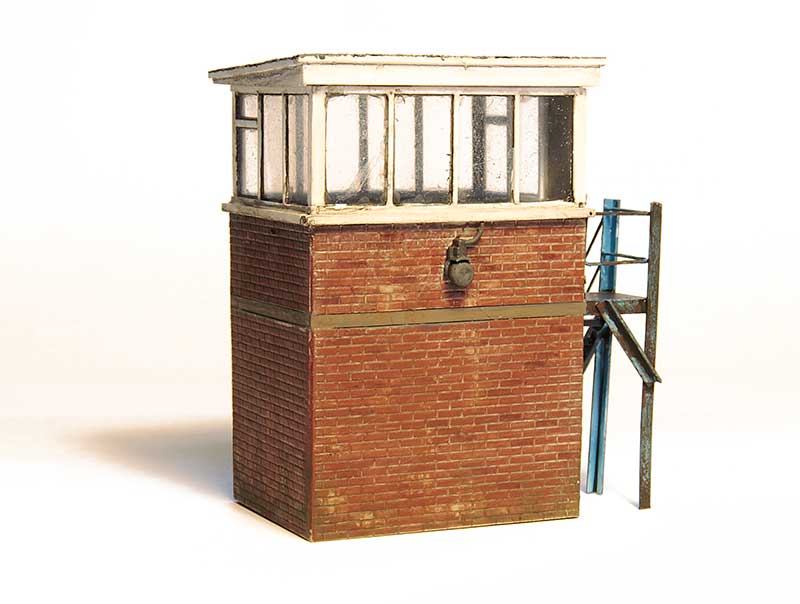 This is a little model of the crossing box from Level Street, modelled in its abandoned state. Ive taken a bit of artistic licence with this as the real building appeared after the layout is set and lasted into the early 1980s. Round oak did tend to move and rebuild things a lot though so a building that became redundant whilst still relatively new wouldn’t have been that unusual for the area. Plus as anyone who’s ever researched a real place will know, not everything at a location will always make a lot of sense. The model is scratch-built with the nifty alarm bell a 3d print kindly supplied by Richard of Mudmagnet Models.
This is a little model of the crossing box from Level Street, modelled in its abandoned state. Ive taken a bit of artistic licence with this as the real building appeared after the layout is set and lasted into the early 1980s. Round oak did tend to move and rebuild things a lot though so a building that became redundant whilst still relatively new wouldn’t have been that unusual for the area. Plus as anyone who’s ever researched a real place will know, not everything at a location will always make a lot of sense. The model is scratch-built with the nifty alarm bell a 3d print kindly supplied by Richard of Mudmagnet Models.
 A few bits dumped agains the platform fence give just a hint that the station doesn’t have long left.
A few bits dumped agains the platform fence give just a hint that the station doesn’t have long left.
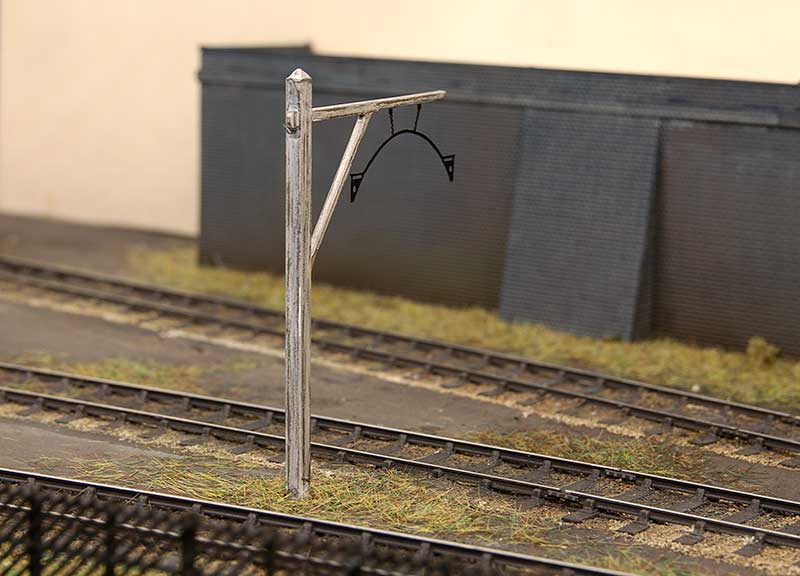 When I rebuilt my loading gauge (a while ago now) I actually built another one at the same time. The frame is scratch-built from brass sections and the bow from Smiths. This actually serves a purpose as provided the layout is properly levelled this is the point where a free rolling wagon will start to move as the siding descends to the same level as the mainline.
When I rebuilt my loading gauge (a while ago now) I actually built another one at the same time. The frame is scratch-built from brass sections and the bow from Smiths. This actually serves a purpose as provided the layout is properly levelled this is the point where a free rolling wagon will start to move as the siding descends to the same level as the mainline.
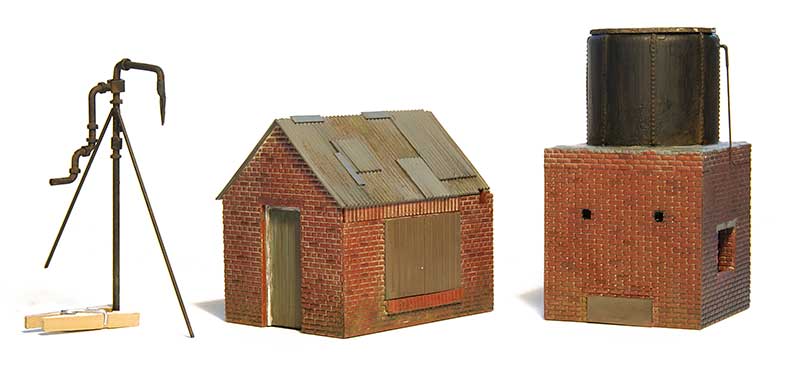 Elements of a rudimentary water tower. The prototype for this stood on the Earl of Dudley’s railway at the link between Oak Lane and Stallings Lane, Near to Himley’s No.8 pit. It survived until 1950. Its Heath Robinson look appealed to me.
Elements of a rudimentary water tower. The prototype for this stood on the Earl of Dudley’s railway at the link between Oak Lane and Stallings Lane, Near to Himley’s No.8 pit. It survived until 1950. Its Heath Robinson look appealed to me.
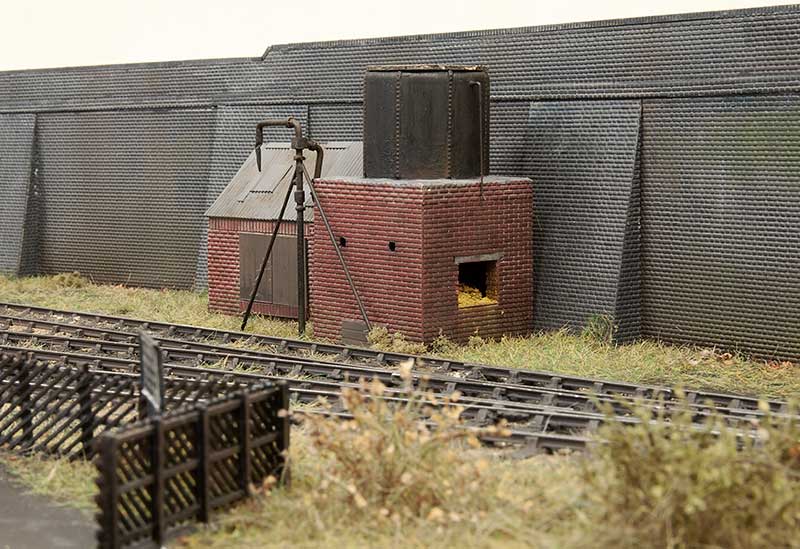 In position on the layout. Its days of servicing the EoD fleet of 0-4-0 saddle tanks are long gone.
In position on the layout. Its days of servicing the EoD fleet of 0-4-0 saddle tanks are long gone.
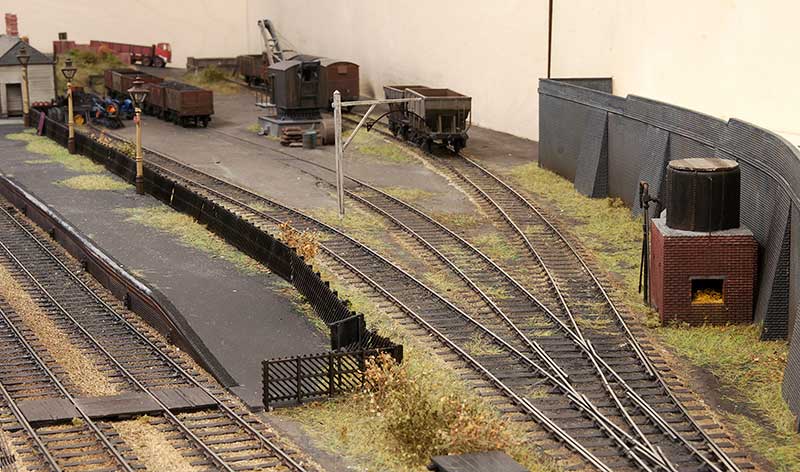
24th September 2021
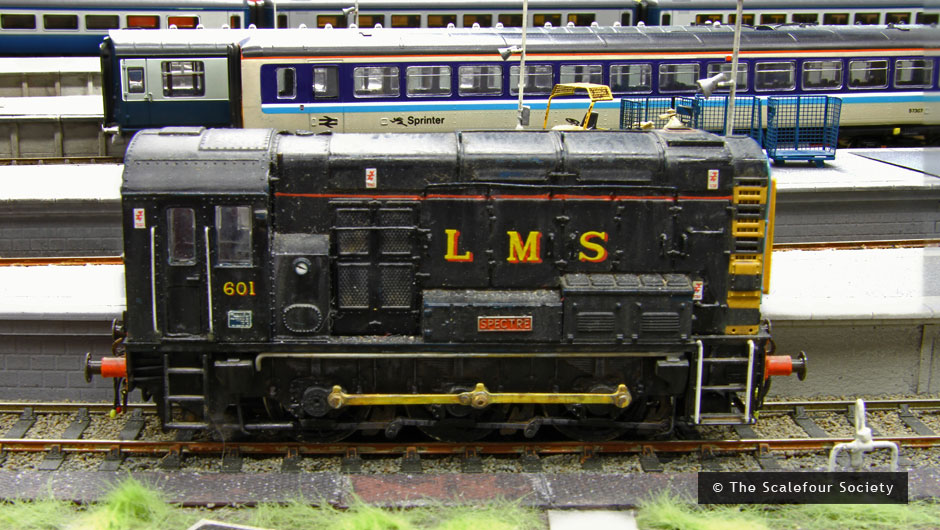 Just a little look-back. This weekend marks 10 years since New Street was last seen in public. Time flies! For more pictures from the show click here.
Just a little look-back. This weekend marks 10 years since New Street was last seen in public. Time flies! For more pictures from the show click here.
Before anyone asks, at the time of writing there are no plans for it to do any more shows (sorry)
A short post in brass
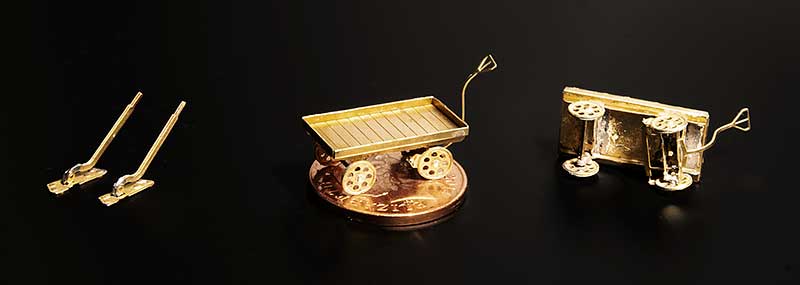 Been fiddling with bits of brass again. I wouldn’t normally bother taking a picture of something as simple as a point lever but I found that the ones I built before were a little vulnerable and easily bent. I haven’t changed the ones i use (Shirescenes) but what I have done is doubled up the levers themselves and they now seem a lot more robust.
Been fiddling with bits of brass again. I wouldn’t normally bother taking a picture of something as simple as a point lever but I found that the ones I built before were a little vulnerable and easily bent. I haven’t changed the ones i use (Shirescenes) but what I have done is doubled up the levers themselves and they now seem a lot more robust.
I’ve built platform trollies before to but this time I have changed the supplier. I think my previous ones were Scalelink but this one is from London Road Models and is much more detailed. It even had a representation of the brake linkages. Regular readers will no doubt know by now I’m a sucker for this sort of thing! The trolly is shown perched on a two pence piece for scale.
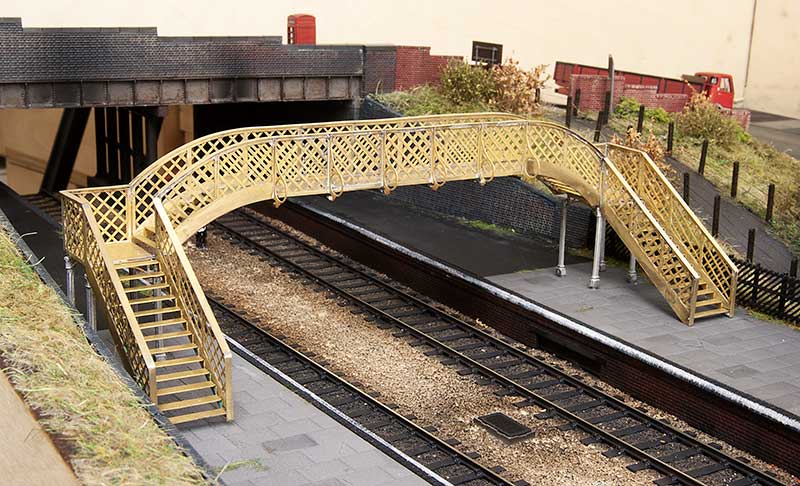 Moving on to something a little more obvious. This is the Churchward models (now sold by Phoenix models) footbridge kit shown in temporary position. As my track spacing is quite wide here I did need to extend the main arch by one panel and, luckily as the etches for the arch are the same, I could use the spare bits that weren’t needed on the facing side. The sides were cut and shut with the new panels grafted in meaning the only bit I needed to fabricate from scratch was the main span floor. An enjoyable kit to build this one.
Moving on to something a little more obvious. This is the Churchward models (now sold by Phoenix models) footbridge kit shown in temporary position. As my track spacing is quite wide here I did need to extend the main arch by one panel and, luckily as the etches for the arch are the same, I could use the spare bits that weren’t needed on the facing side. The sides were cut and shut with the new panels grafted in meaning the only bit I needed to fabricate from scratch was the main span floor. An enjoyable kit to build this one.
Revisions and clutter
Remember the diagram 1973 mineral wagon I posted a few entries ago? Turns out I missed some of the reinforcing bits that were added after they were built. Im not sure how as they were in the prototype pictures I was looking at! Anyway thats been corrected now
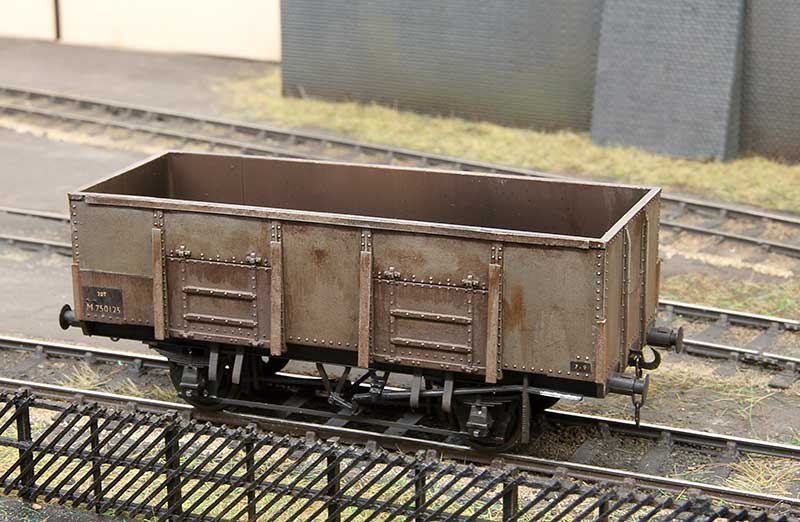 Ive finished off a few Bachmann RTR wagons too.
Ive finished off a few Bachmann RTR wagons too.
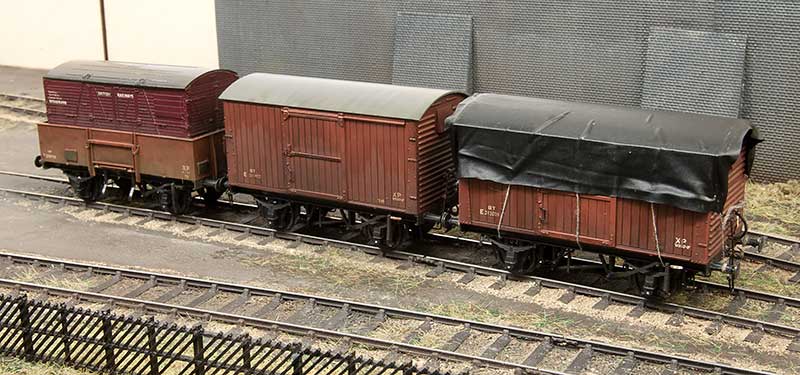 The steel high-fit was actually already done. Ive just added a container to it. The other 2 are actually 2 of the 3 vans I first brought for the layout. Discounted in Modellers Mecca bargain bin! The tarpaulin is black latex cut from a surgical glove.
The steel high-fit was actually already done. Ive just added a container to it. The other 2 are actually 2 of the 3 vans I first brought for the layout. Discounted in Modellers Mecca bargain bin! The tarpaulin is black latex cut from a surgical glove.
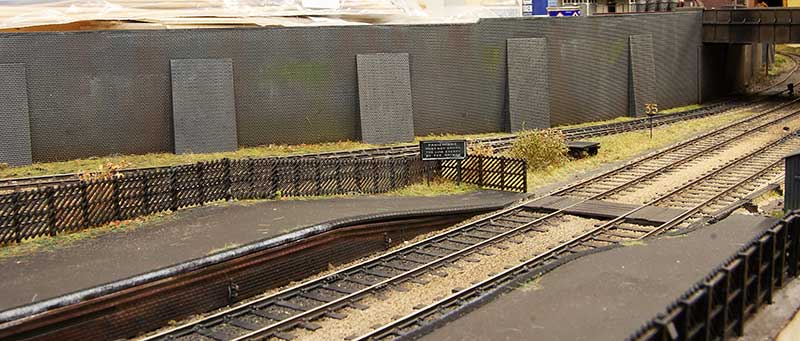 When I built the retaining wall for this side of the bridge I did intend to do something a little more substantial but decided that It would look weird if the wall was 2 different designs. However a friend mentioned that the buttresses looked a little too puny so I reverted to what i should have done originally and modified the existing wall to match. I admit I did want something more grandiose than this but for where it is it wouldn’t have made a lot of sense to have something to elaborate. I definitely don’t subscribe to that inane ‘rule 1’ idea of its your layout do what you want. There has to be some degree of plausibility in there somewhere.
When I built the retaining wall for this side of the bridge I did intend to do something a little more substantial but decided that It would look weird if the wall was 2 different designs. However a friend mentioned that the buttresses looked a little too puny so I reverted to what i should have done originally and modified the existing wall to match. I admit I did want something more grandiose than this but for where it is it wouldn’t have made a lot of sense to have something to elaborate. I definitely don’t subscribe to that inane ‘rule 1’ idea of its your layout do what you want. There has to be some degree of plausibility in there somewhere.
Clutter – What is a yard if it doesn’t have some clutter in it? Much like the retaining walls though you don’t want to go too mad. At the end of the day this is someones product and they aren’t all that likely to leave it lying around on the floor.
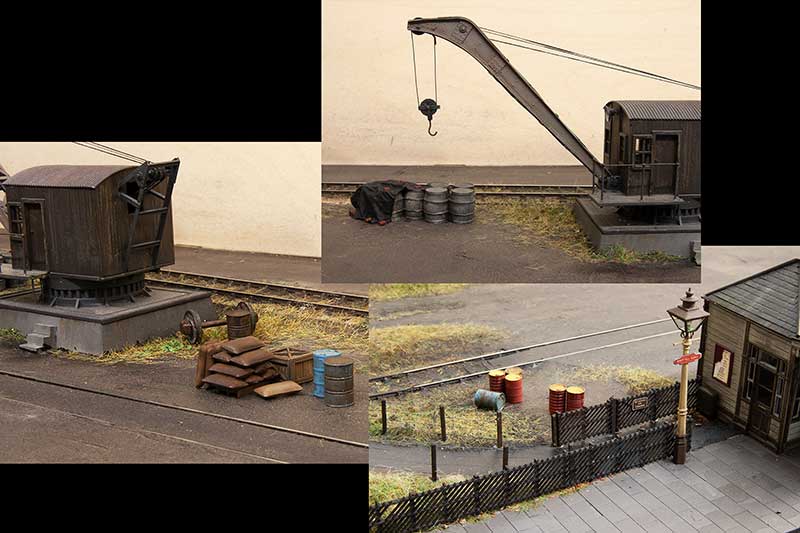 So I opted for 3 small groups of stuff as can be seen above.
So I opted for 3 small groups of stuff as can be seen above.
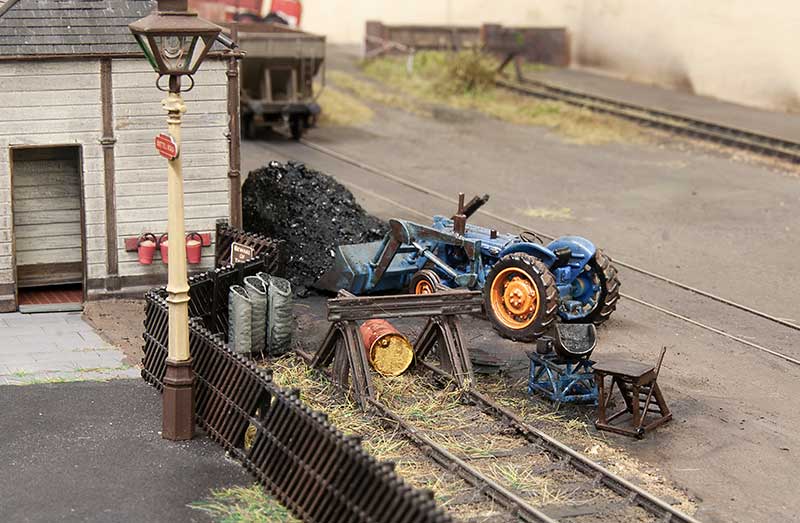 I always wanted some coal facility and I had this in mind when I built my tractor. Again nothing too posh, no coal staithes or anything like that – just a few piles and some more clutter. The steps, scales and the conveyor (behind the tractor) are 3D prints kindly donated by my friend John.
I always wanted some coal facility and I had this in mind when I built my tractor. Again nothing too posh, no coal staithes or anything like that – just a few piles and some more clutter. The steps, scales and the conveyor (behind the tractor) are 3D prints kindly donated by my friend John.
Finally a couple more evening shots.
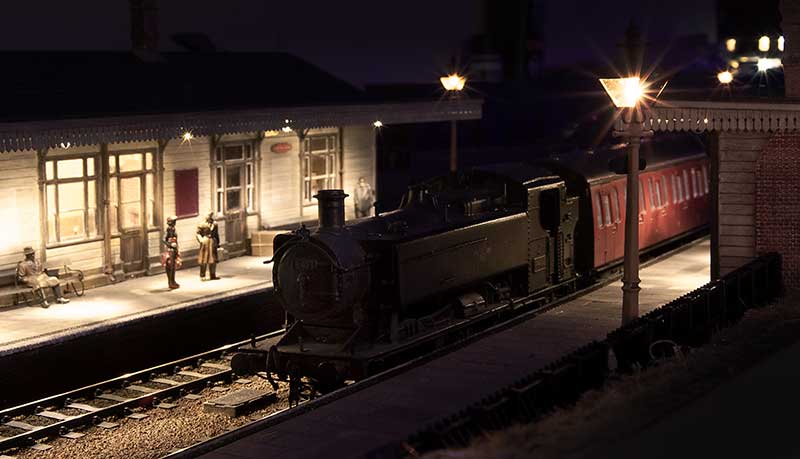
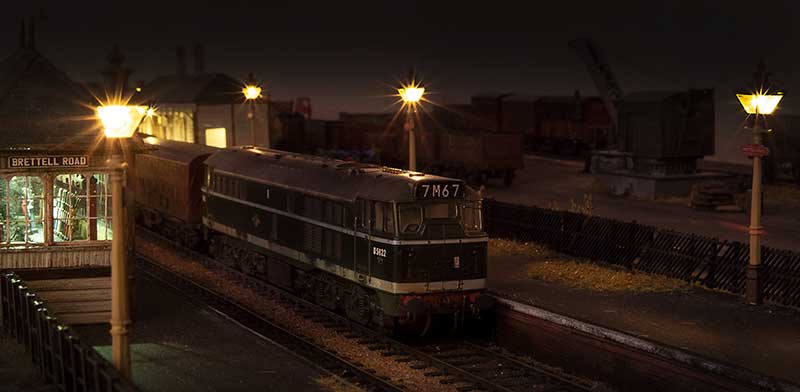
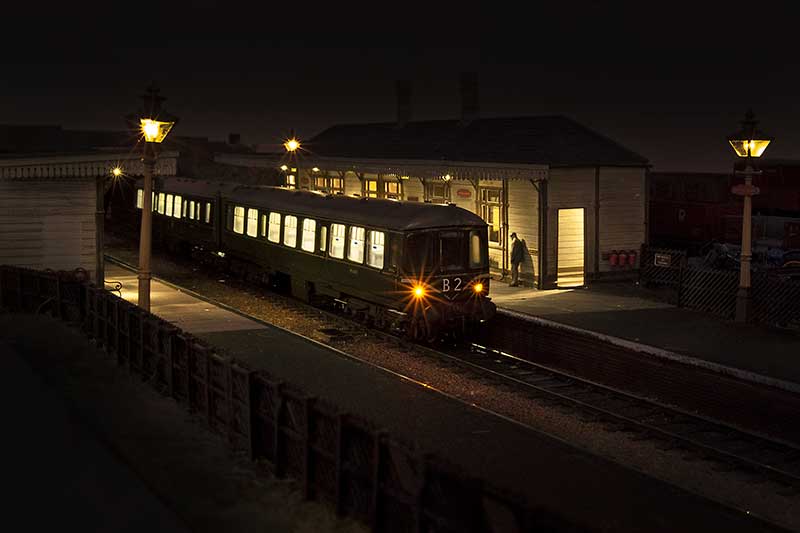
A few in progress lorry kits
With my first demo in a few years (my first exhibition in any form in a few years actually) coming up in a few weeks*, I thought it an idea to do a couple of in progress lorries as a change to all the finished stuff I usually drag along to this sort of thing.
Both are Langley kits and were chosen for absolutely no other reason than they popped up cheaply on ebay! OK they were a little interesting anyway and i thought the dumpy little Dodge 5 ton tipper truck was kinda cute. The Milk tanker is a Leyland Beaver and both hail from the end of the 40s so they would likely be pretty tired by the time they reach Brettell Road. The make do and mend attitude of the Black Country would mean they might soldier on for that long but the impending Motor Vehicles (Tests) Regulations of 1960 must mean their days are likely numbered!
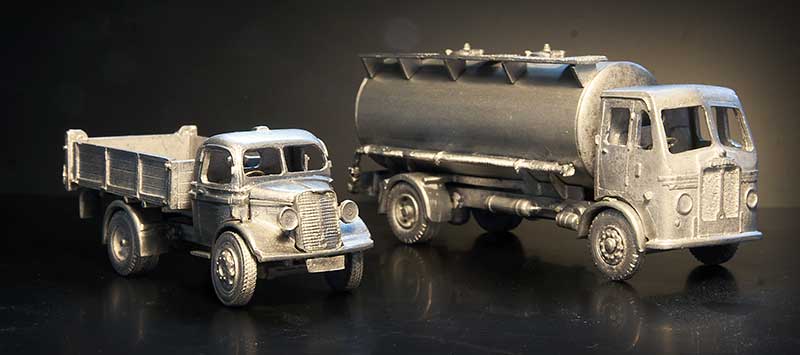
*See the news page
14th September 2021
With the model railway exhibition circuit starting to show signs of emerging from its enforced hibernation I have updated the shows page. However with Brettell road undergoing its rebuild and one last show for Birmingham Moor Street I will admit it’s somewhat slim pickings at the moment. Heres a link.
Theres no Scaleforum this year but what there is instead is a set of smaller events from some of the area groups. For a full list click here.
The one I will be attending is this one
North Norfolk Area Group Event 25th September 2021
The Copeman Centre, Hall Street, BRISTON NR24 2LG
https://www.thecopemancentre.org.uk/
Opening times: 10:00 – 16:00. Admission free.
Light refreshments will be available and for this venue there is no need to pre-book.
The following layouts will be present:
North Elmham – Currently under construction by the North Norfolk Area Group, this layout will depict the station on the Wells next the Sea branch with its grain and milk traffic giving some variety from the norm. The layout will be set in the late 50s/early 60s period.
Obbekaer – A Danish independent line connecting Rebe, Gram and Vojens in South Jutland from Geraint Hughes set in the mid 50s. The Model is built to P87 standards.
Wheal Elizabeth – The end of a Cornish China Clay branch set in the 1970s/early 80s. from Jeremy Good.
We will also have the North Norfolk Area Group’s test track available for those who want to give their stock the chance to stretch its legs.
We will have six demonstrations, which are:
Modelling road vehicles – Jim Smith-Wright
Air-braked wagons – Phil Eames
Etched brass carriage construction – Tony Brenchley
Kit-bashing plastic coach kits – Alan Hall
Turnouts with a difference, an approach to building the inter-laced variety – John Geggie
Cavelex Models – will be showing production models and their latest samples for visitors to examine and will be very happy to discuss any aspect of their products
Hope to see some of you there.
Signs of life
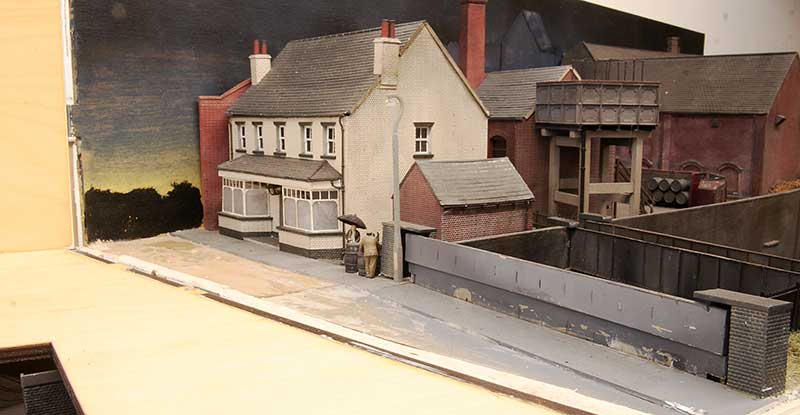 With the Stourbridge end of the layout looking half decent attention has turned to the Dudley end of the new boards or the middle of the layout. Theres a few things that jarred about this scene now that it’s more open. Before you couldn’t really see them. The pavement doesn’t flow properly and there are big gaps at the end of the bridge girder. Also the lower part wasn’t finished. When I designed the bridge I did have the foresight to include a half etch to allow the rivets on this side to be punched through. However when I built it i didn’t bother! Ive already pulled up the road.
With the Stourbridge end of the layout looking half decent attention has turned to the Dudley end of the new boards or the middle of the layout. Theres a few things that jarred about this scene now that it’s more open. Before you couldn’t really see them. The pavement doesn’t flow properly and there are big gaps at the end of the bridge girder. Also the lower part wasn’t finished. When I designed the bridge I did have the foresight to include a half etch to allow the rivets on this side to be punched through. However when I built it i didn’t bother! Ive already pulled up the road.
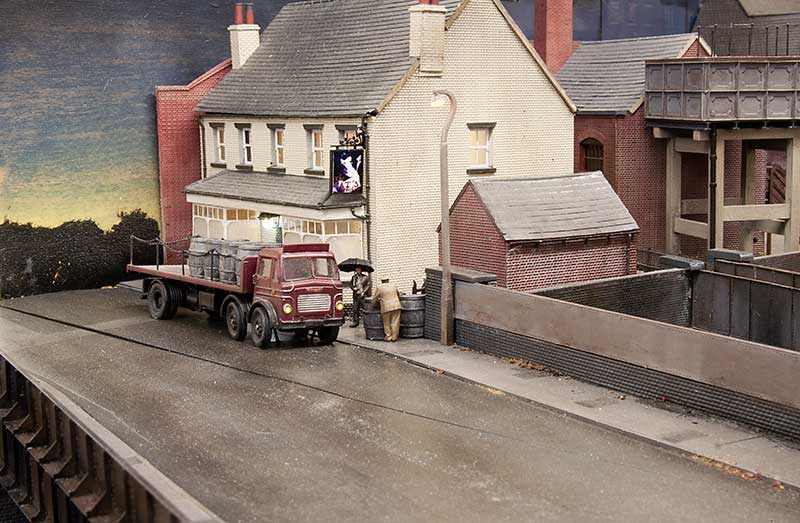 So the road and pavements have been redone. I made an overlay for the bridge from paper. The pub sign is from Model scenics and features our much missed cat Moo. The figures are from Modelu.
So the road and pavements have been redone. I made an overlay for the bridge from paper. The pub sign is from Model scenics and features our much missed cat Moo. The figures are from Modelu.
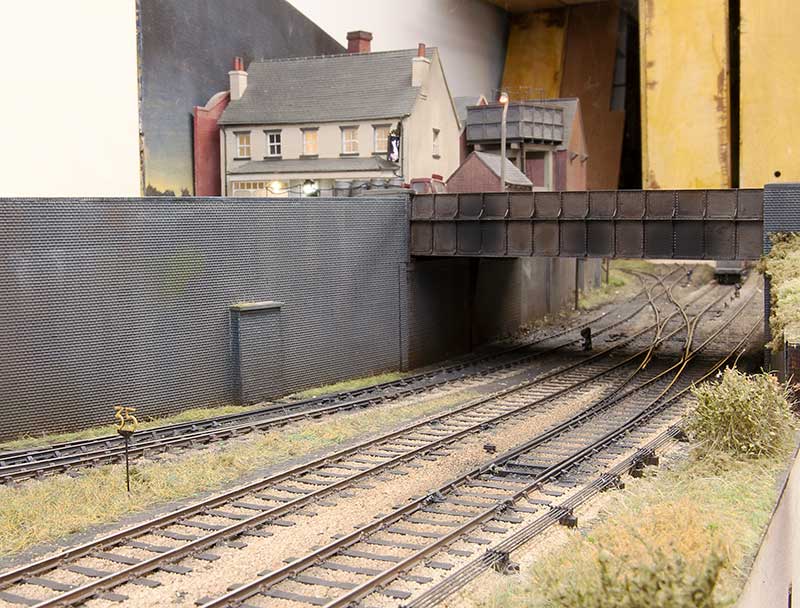 The bridge from track level. Ive added the retaining walls with some nifty top capping that Tim kindly cut for me.
The bridge from track level. Ive added the retaining walls with some nifty top capping that Tim kindly cut for me.
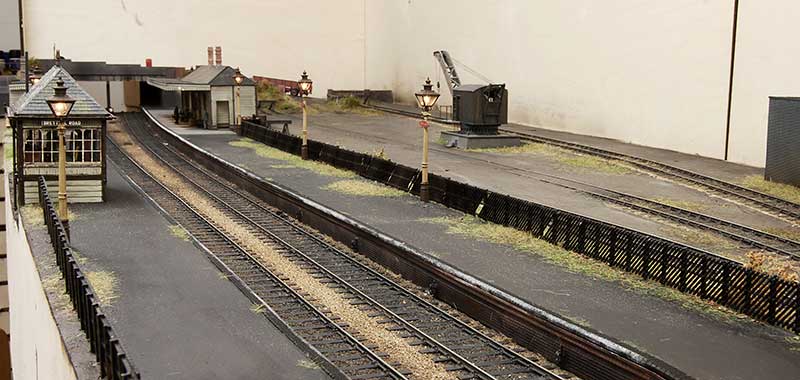 Turning around we see an overview of the somewhat neglected platforms.
Turning around we see an overview of the somewhat neglected platforms.
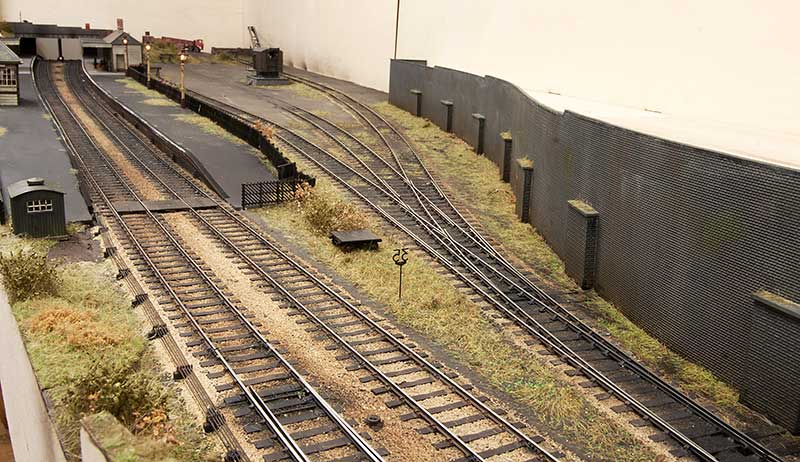 An overview of progress so far.
An overview of progress so far.
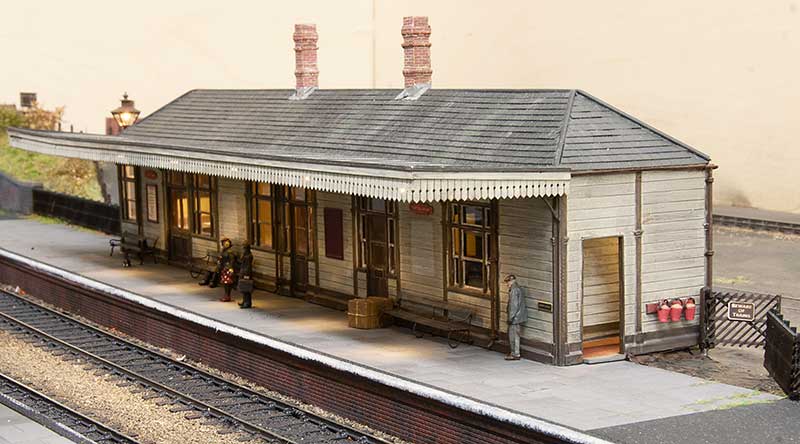 Ive added a scattering of people from Modelu and Airfix. I thought the lady with the umbrella was particularly suitable. I still need to do more work to bed this end of the building in. Considering this is the rush hour theres not many people about.
Ive added a scattering of people from Modelu and Airfix. I thought the lady with the umbrella was particularly suitable. I still need to do more work to bed this end of the building in. Considering this is the rush hour theres not many people about.
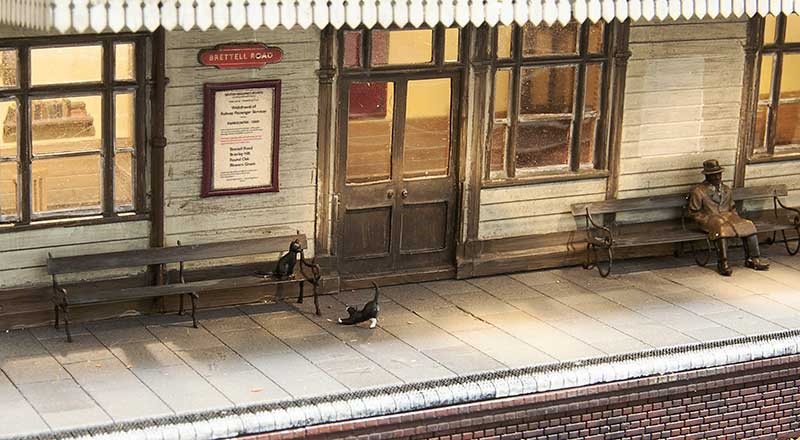 The station has 2 cats. The sensible one is Shadow while the mischievous one who wants to play is comet They are more interested in chasing each other than the local rat population!
The station has 2 cats. The sensible one is Shadow while the mischievous one who wants to play is comet They are more interested in chasing each other than the local rat population!
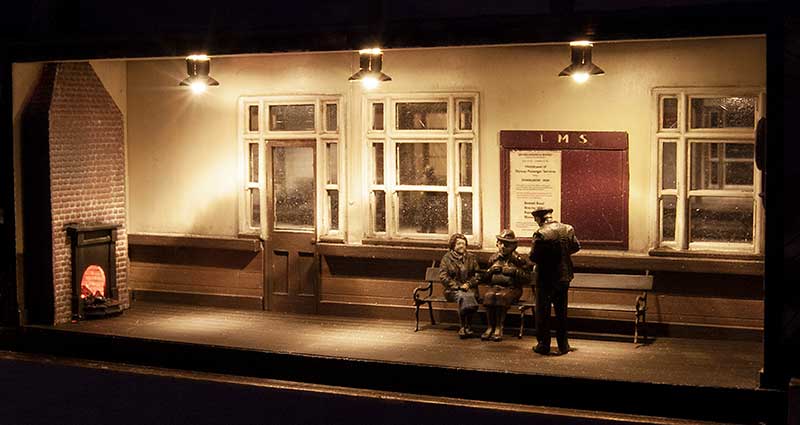 On the other platform a couple of elder ladies discuss the immanent closure of the station with the station master.
On the other platform a couple of elder ladies discuss the immanent closure of the station with the station master.
Agent 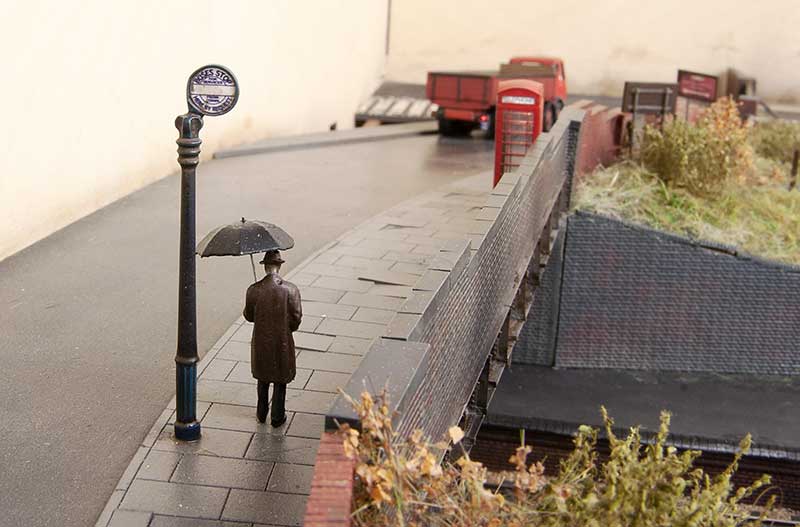 A gent waits for the bus. It’s late as usual!
A gent waits for the bus. It’s late as usual!
Now that the some of the lighting is in place a few dark shots.

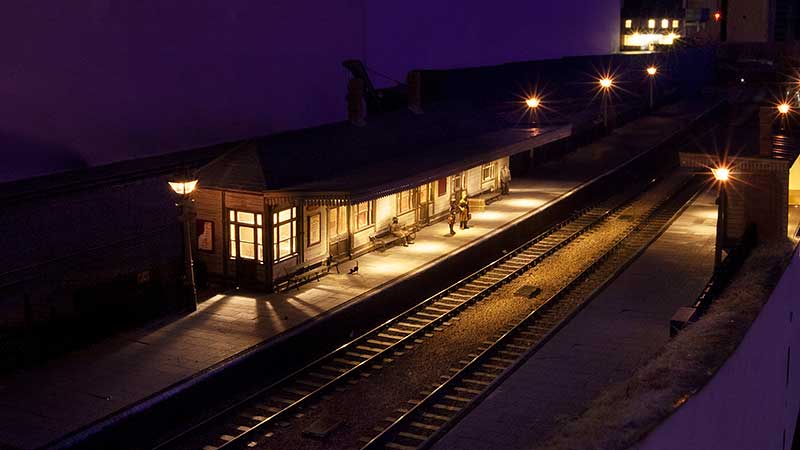
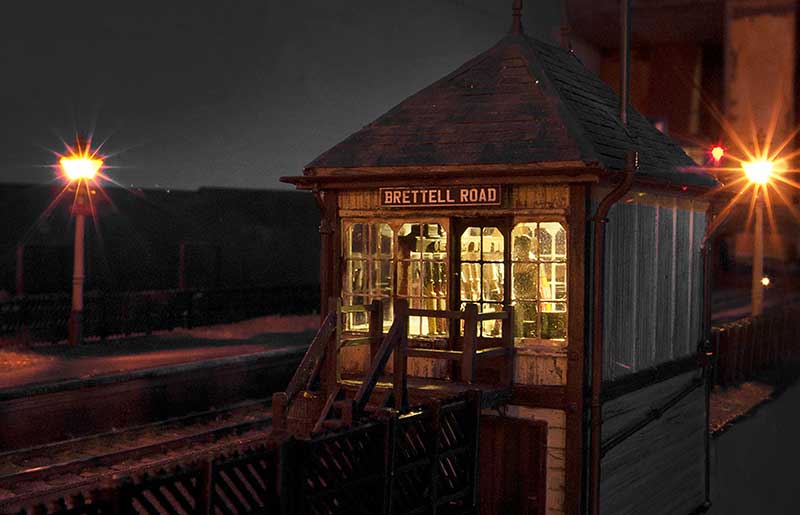
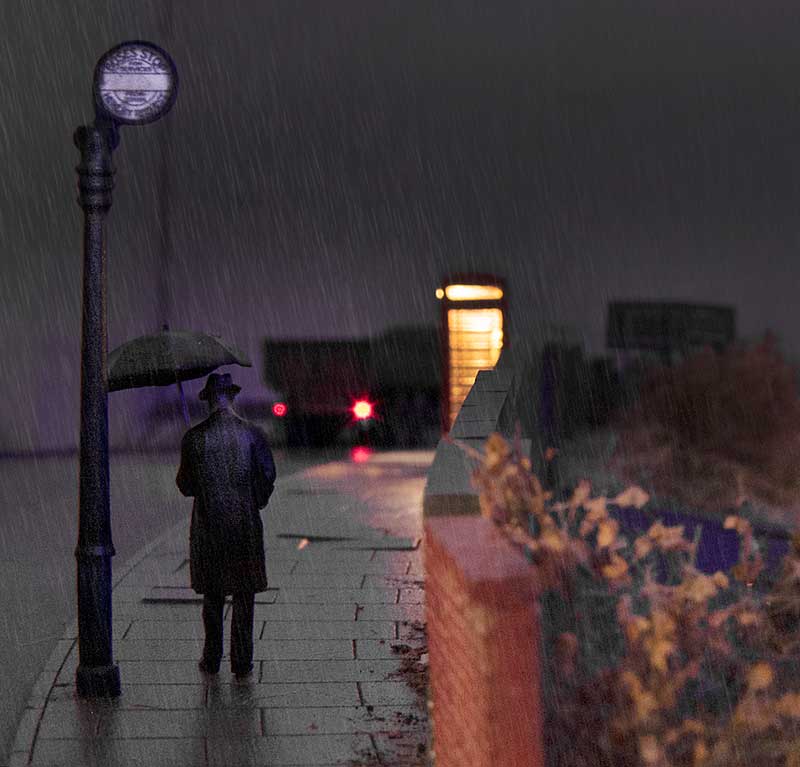

Greenery and decoration.
I’ve reached the stage where all the significant greenery is pretty much done and I can move on to some titivating of parts of the layout.
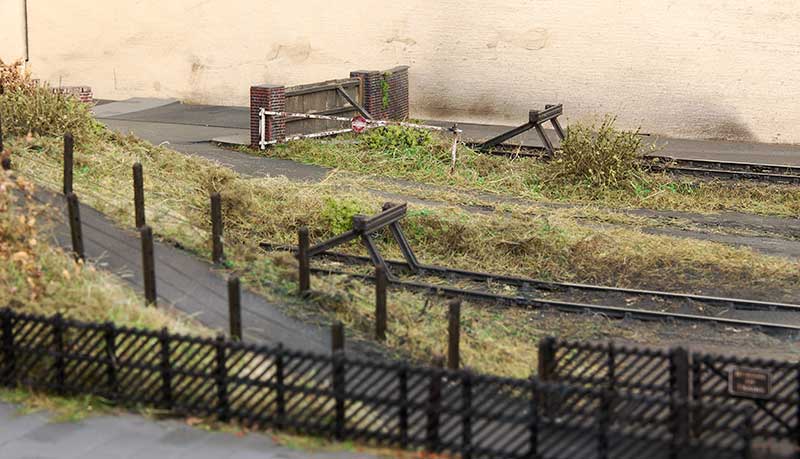 I’ve made a basic wooden fence to block off the line that crossed the road originally. The rudimentary gate (which looks like it hasn’t been actually used for years) is simply a few bits of 1x1mm brass soldered together.
I’ve made a basic wooden fence to block off the line that crossed the road originally. The rudimentary gate (which looks like it hasn’t been actually used for years) is simply a few bits of 1x1mm brass soldered together.
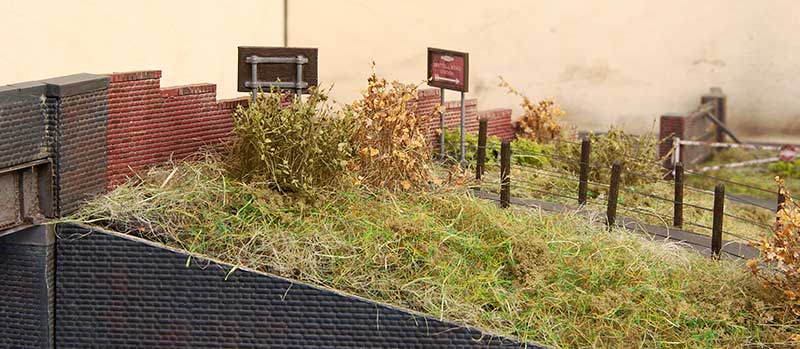 Proverbially walking up the road a little we come to the station signs. These are based on a photo I found somewhere. The fading on the signs themselves was actually an accident. The result of me handling the printout a little too early.
Proverbially walking up the road a little we come to the station signs. These are based on a photo I found somewhere. The fading on the signs themselves was actually an accident. The result of me handling the printout a little too early.
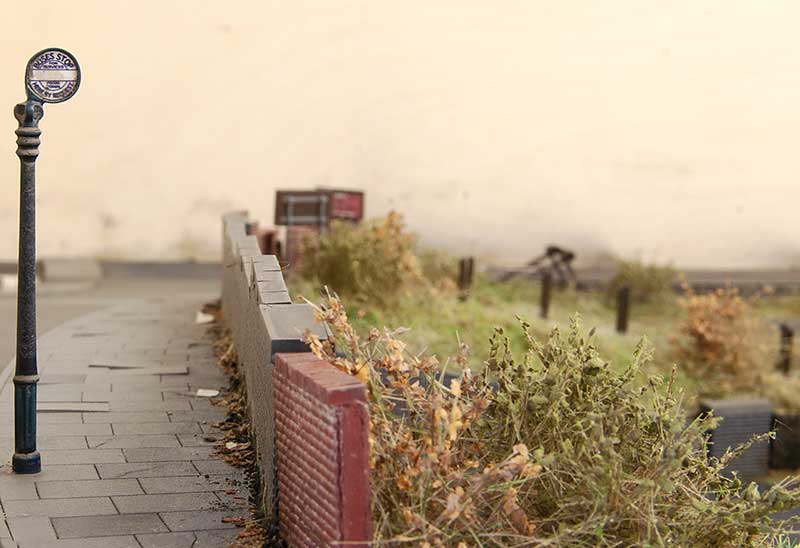 Continuing our walk we come to this. What can be more of a model railway cliché than the good old bus on a bridge? Well since I am not going to be doing any buses for this layout I have gone for a midlands style bus stop instead. The main column was something I had in my spares box. The rain on the layout is always going to be going left to right as you look at it, so it makes sense that the autumn leaves and litter do the same. The top of the bridge is particularity known by the locals as being a bit blustery. (Theres actually a real location nearby known locally as ‘windy corner’)
Continuing our walk we come to this. What can be more of a model railway cliché than the good old bus on a bridge? Well since I am not going to be doing any buses for this layout I have gone for a midlands style bus stop instead. The main column was something I had in my spares box. The rain on the layout is always going to be going left to right as you look at it, so it makes sense that the autumn leaves and litter do the same. The top of the bridge is particularity known by the locals as being a bit blustery. (Theres actually a real location nearby known locally as ‘windy corner’)
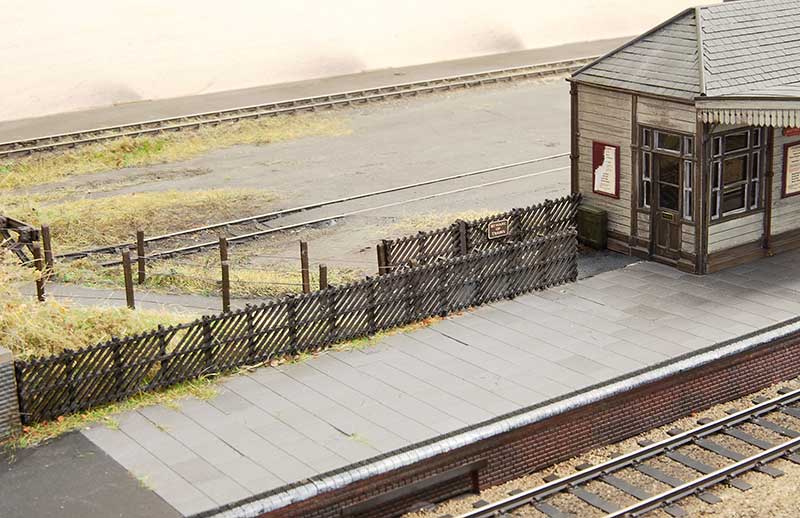 Peering over the bridge we see the lower end of the station footpath. The Midland style fencing and wire fencing posts both come from Scale Model Scenery as does the little beware of trains sign.
Peering over the bridge we see the lower end of the station footpath. The Midland style fencing and wire fencing posts both come from Scale Model Scenery as does the little beware of trains sign.
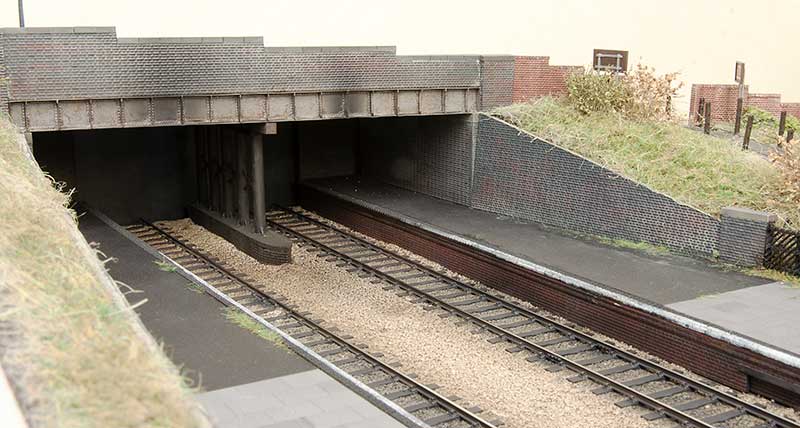 Looking back at the bridge we just walked over. The girder is 2 of my previously designed etches combined together. I still need to add the top capping to the sloping walls yet.
Looking back at the bridge we just walked over. The girder is 2 of my previously designed etches combined together. I still need to add the top capping to the sloping walls yet.
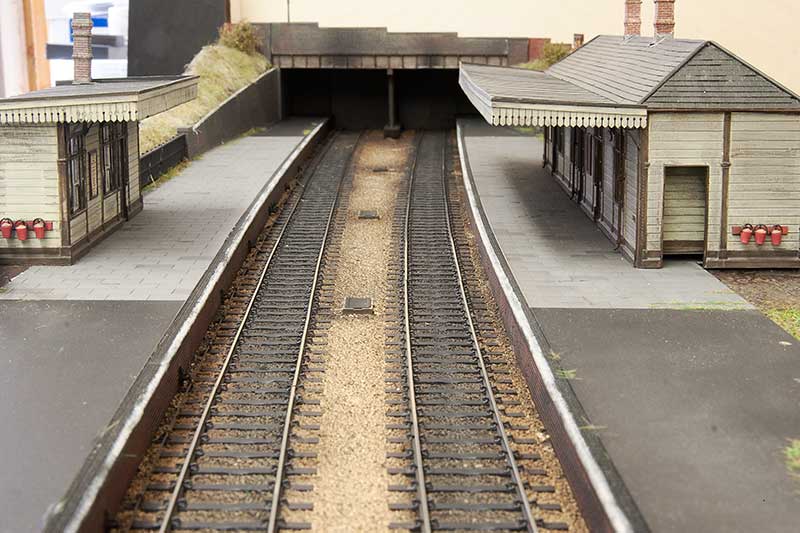 Overview looking towards Stourbridge. The 2 buildings are still just loosely placed at this stage.
Overview looking towards Stourbridge. The 2 buildings are still just loosely placed at this stage.
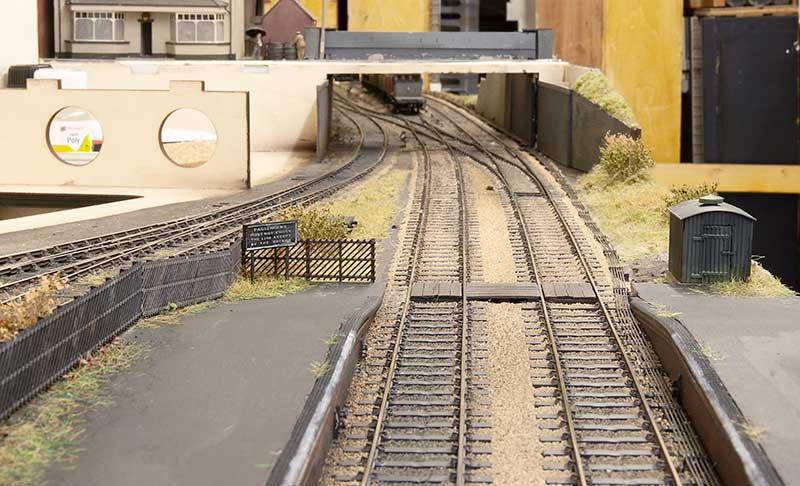 … and towards Dudley. You’ll have to use your imagination for the moment for fill in the bridge and the wall on the left.
… and towards Dudley. You’ll have to use your imagination for the moment for fill in the bridge and the wall on the left.
 Old warning sign from Ambis Engineering
Old warning sign from Ambis Engineering
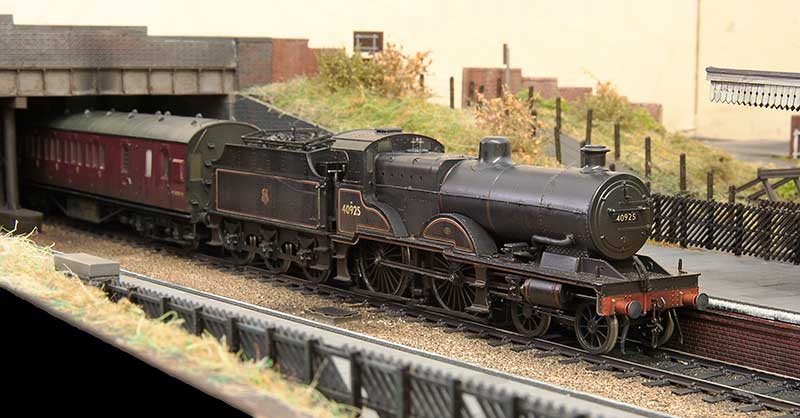 A train! Remember those?
A train! Remember those?
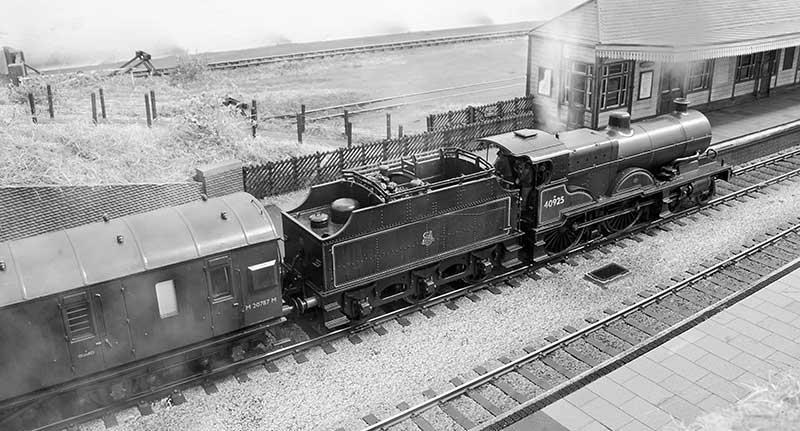
The march of progress
Ive been a bit busy. All the track is not ballasted and the first stage of weathering in complete. I have also put the platforms in.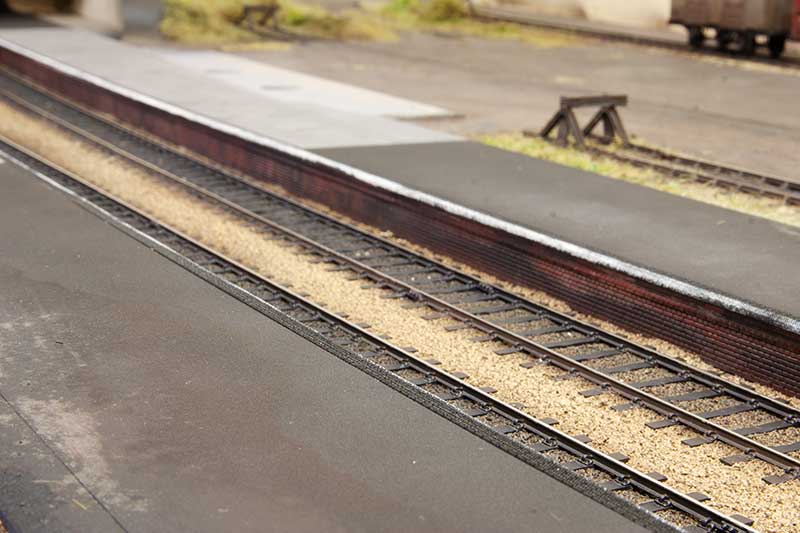 The sides and tops were cut when I was over at Tims. The brick platform edges are something Tim developed and they do look really smart.
The sides and tops were cut when I was over at Tims. The brick platform edges are something Tim developed and they do look really smart.
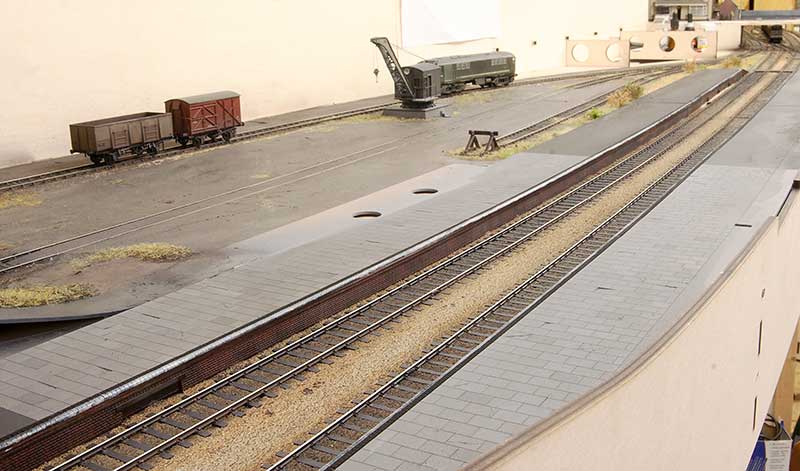 Overview from the Stourbridge end.
Overview from the Stourbridge end.
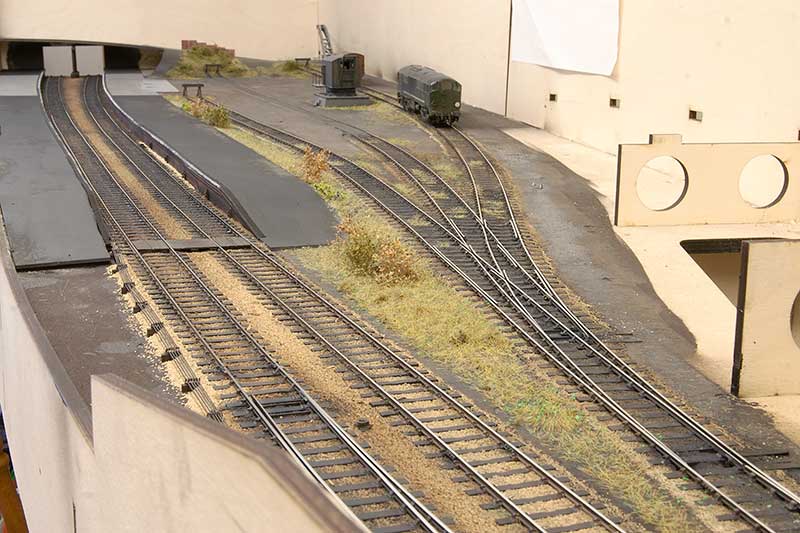 And from the Dudley end
And from the Dudley end
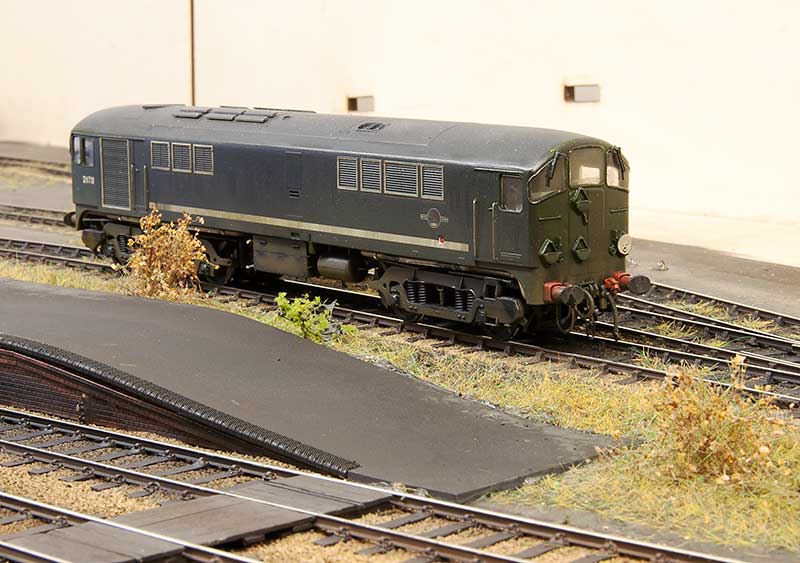 Co-Bo lurks in the weeds.
Co-Bo lurks in the weeds.
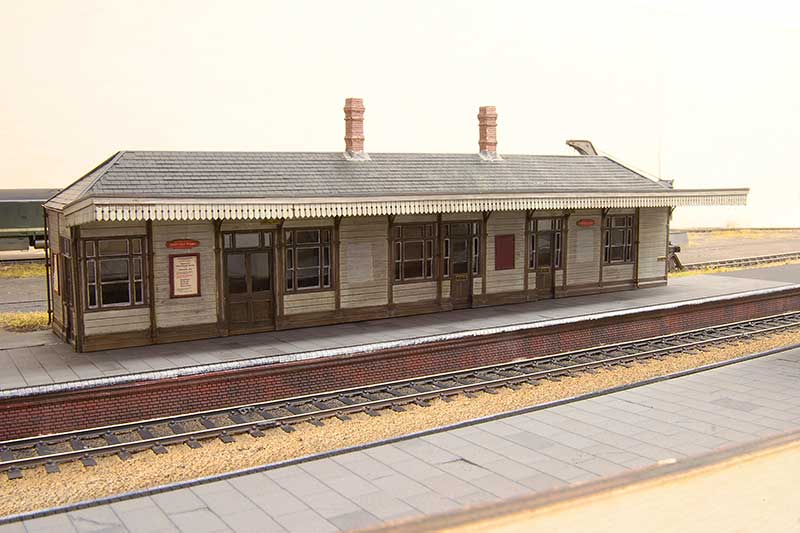 Up until now i have resisted the urge to plonk the building in place but my resistance has now caved.
Up until now i have resisted the urge to plonk the building in place but my resistance has now caved.
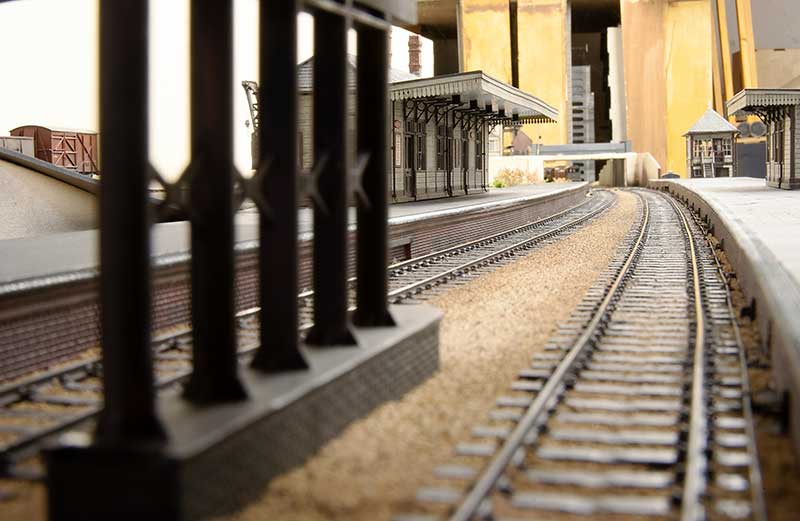 View from under the bridge. This gives a good idea of the elevation changes in the yard. And before anyone says anything, doing the point rodding was probably a bit of a pointless exercise if I’m honest!
View from under the bridge. This gives a good idea of the elevation changes in the yard. And before anyone says anything, doing the point rodding was probably a bit of a pointless exercise if I’m honest!
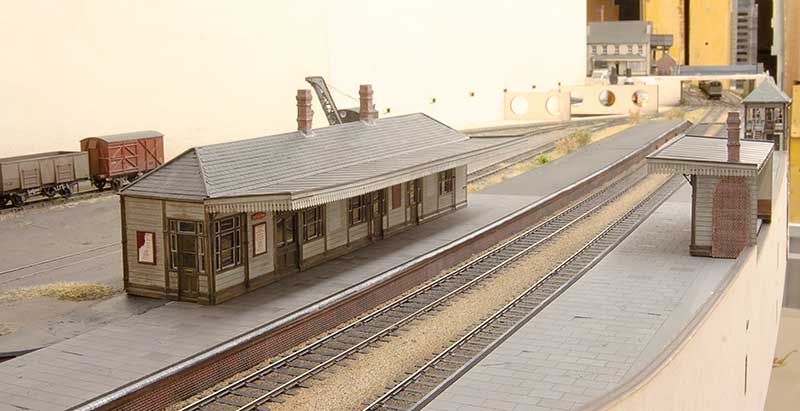
Bitsa post
This post kind of jumps around a little but lets start with a simple wagon as we’ve not had one of those for a while. 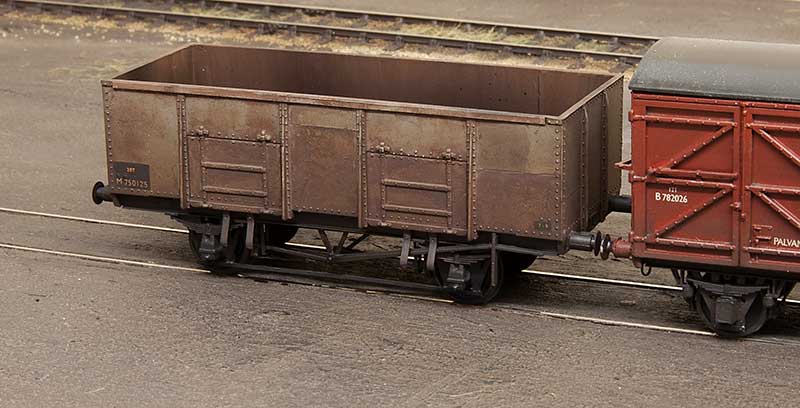 LMS diagram 1973 mineral wagon. These were a little odd as they had no end doors just side ones. The model was created by splicing 2 sections of the Dapol (ex Airfix) mineral wagon body together and mating the result with a Parkside 12 ft wheelbase chassis. The W-irons are Bill Bedford, door springs Rumney models and buffers from Accurascale.
LMS diagram 1973 mineral wagon. These were a little odd as they had no end doors just side ones. The model was created by splicing 2 sections of the Dapol (ex Airfix) mineral wagon body together and mating the result with a Parkside 12 ft wheelbase chassis. The W-irons are Bill Bedford, door springs Rumney models and buffers from Accurascale.
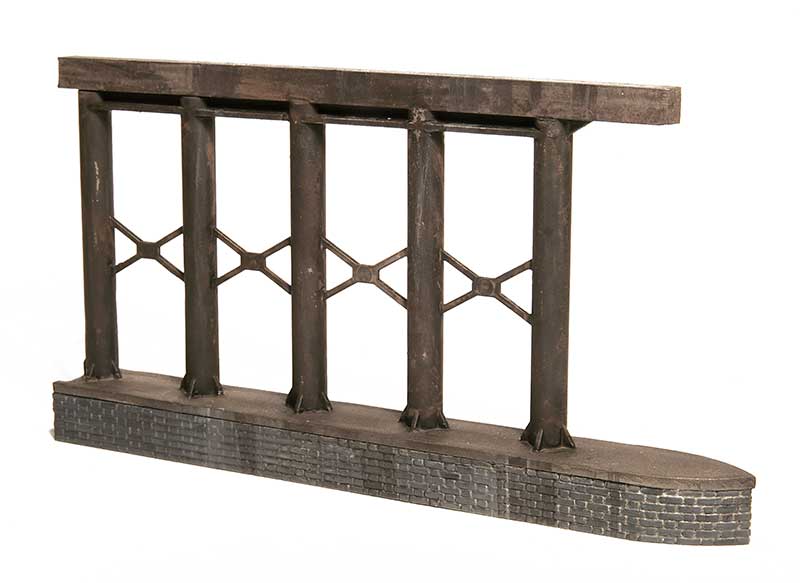 Both the real Brettell Lane and Round Oak stations had central supports under the bridges. As this will be right at the end of the layout, under a bridge and in the dark I didn’t feel I had to go mad as a silhouette is pretty much all thats needed. The main pillars are actually nothing more than a couple of Hornby gradient supports spliced together.
Both the real Brettell Lane and Round Oak stations had central supports under the bridges. As this will be right at the end of the layout, under a bridge and in the dark I didn’t feel I had to go mad as a silhouette is pretty much all thats needed. The main pillars are actually nothing more than a couple of Hornby gradient supports spliced together.
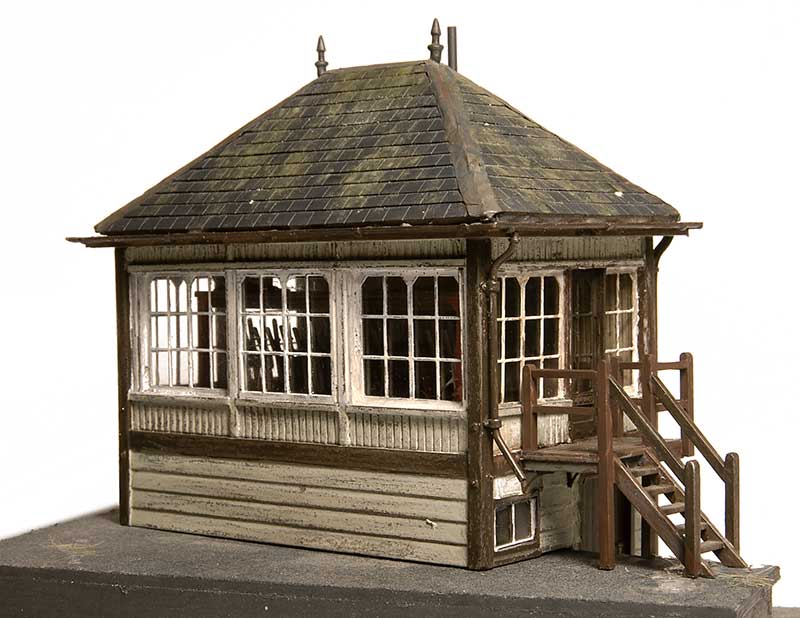 I mentioned in a recent post that i needed to reverse my signal box so the steps are at the opposite end. Thats ticked off now and the results can be seen above. To see the original build click here.
I mentioned in a recent post that i needed to reverse my signal box so the steps are at the opposite end. Thats ticked off now and the results can be seen above. To see the original build click here.
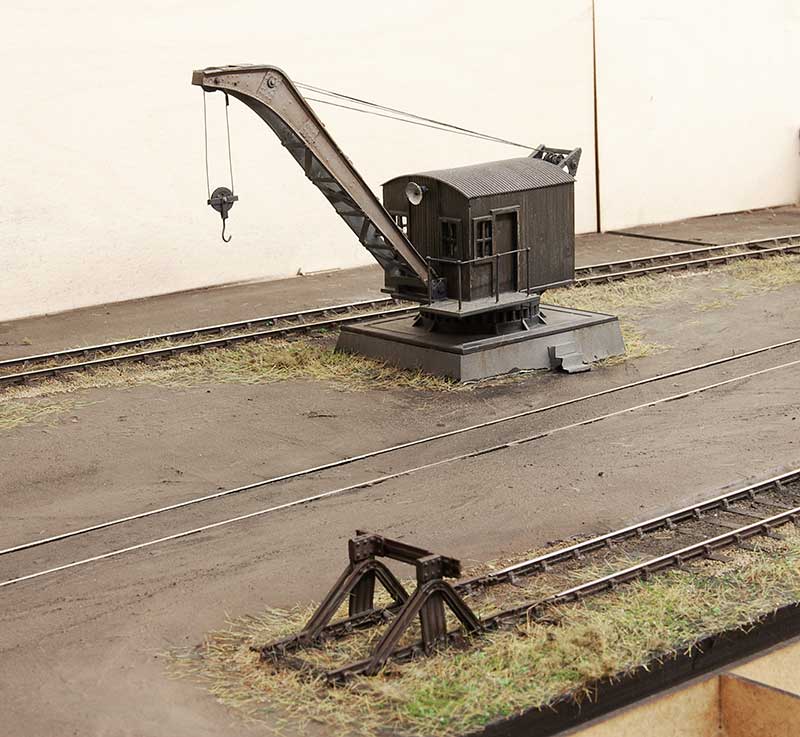 Moving back to the layout itself the much modified Airfix crane has now been planted and the yard track has been ballasted and suitably ‘neglected’.
Moving back to the layout itself the much modified Airfix crane has now been planted and the yard track has been ballasted and suitably ‘neglected’.
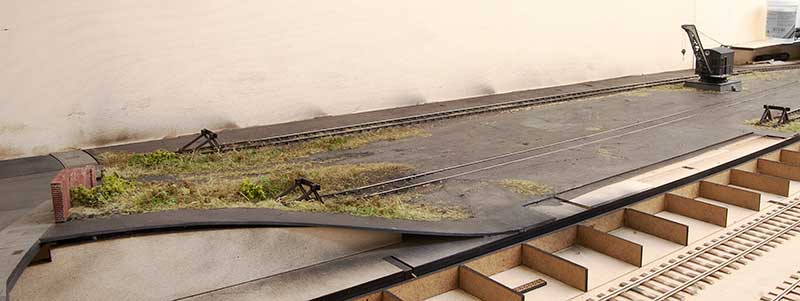 Overall view of the yard so far.
Overall view of the yard so far.
Landscaping and a couple of firsts.
Don’t worry, I’ve not ditched model trains and took up gardening. As far as I am concerned a garden is just somewhere where a model railway shed should live!
With the track and wiring done on Brettell Road part 2 thoughts have turned to the landscaping of the yard. 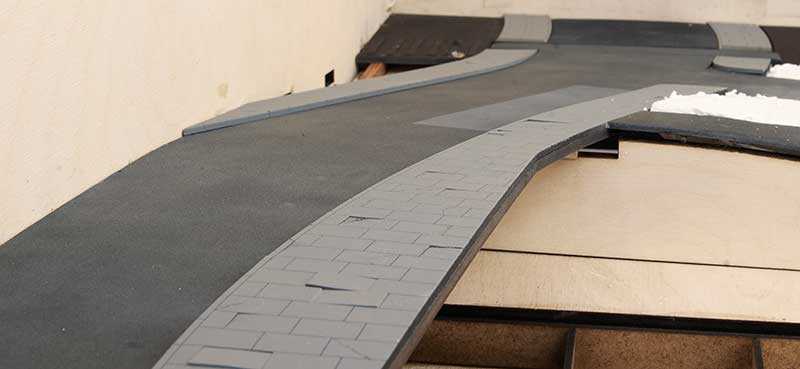 Before I could start on the yard I needed to get the road in as this will need to be blended into the yard. The parts for this were cut out at Tim’s but I did add a layer of 1mm balsa to the road and sanded a camber into it. The thing with laser cutters is they are so neat. By using 2mm mdf for the pavements i could carve away some of the slabs to make it all look a bit more scruffy. I also cut a few of the slabs out completely on the laser so that I could add plasticard instead and do a couple of raised slabs. Brettell Road is set well before the ‘where theres blame theres a claim’ culture. I guess people back then just looked where they were going or called themselves an idiot if they ended up on their backsides!
Before I could start on the yard I needed to get the road in as this will need to be blended into the yard. The parts for this were cut out at Tim’s but I did add a layer of 1mm balsa to the road and sanded a camber into it. The thing with laser cutters is they are so neat. By using 2mm mdf for the pavements i could carve away some of the slabs to make it all look a bit more scruffy. I also cut a few of the slabs out completely on the laser so that I could add plasticard instead and do a couple of raised slabs. Brettell Road is set well before the ‘where theres blame theres a claim’ culture. I guess people back then just looked where they were going or called themselves an idiot if they ended up on their backsides!
This is my nod to Brierley Hill’s level street. Which if you’ve ever been there, is anything but level! At the bottom is a now abandoned level crossing (the real Level street had 2 that were part of the Round Oak system). The line it was on now forms the back siding. The road will need more work yet and weathering but this was far enough to let me move to the yard.
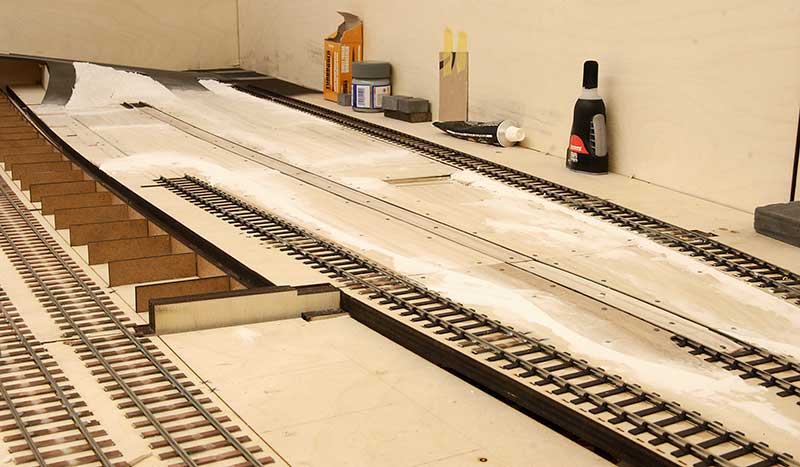 I’ve never done inlaid track before and, added to the bright idea to have different levels, I figured the easiest way would be to infill the gaps with layers of balsa The top layer is 1mm thick and is glued to various different shapes underneath as I didn’t want it to be all that flat. The infill in the track is 1.5mm balsa as I figured a half mill difference between the surface and the rail would aid track cleaning and wouldn’t be noticeable. I used track pins to hold it all together as well as PVA. Incidentally, I think this was the first time I’ve ever brought track pins!
I’ve never done inlaid track before and, added to the bright idea to have different levels, I figured the easiest way would be to infill the gaps with layers of balsa The top layer is 1mm thick and is glued to various different shapes underneath as I didn’t want it to be all that flat. The infill in the track is 1.5mm balsa as I figured a half mill difference between the surface and the rail would aid track cleaning and wouldn’t be noticeable. I used track pins to hold it all together as well as PVA. Incidentally, I think this was the first time I’ve ever brought track pins!
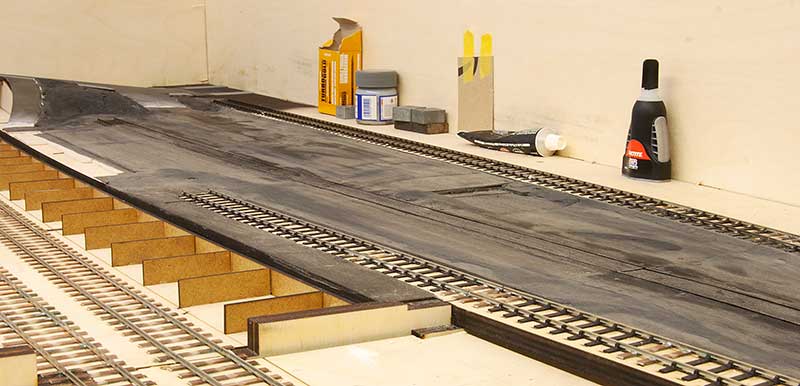 Despite my half mil’ gap idea i was still a little concerned that track cleaning would result in patches of nice fresh wood showing through. So rather than paint I decided to stain the wood black.
Despite my half mil’ gap idea i was still a little concerned that track cleaning would result in patches of nice fresh wood showing through. So rather than paint I decided to stain the wood black.

Time for another new (to me) product. I’ve used 2 colours of ‘mud’ from WWS Scenics. Peat and dark brown. These are like a very smooth liquidly filer. I used the peat first with the dark brown over the top. Applied with a plastic spatular and then stippled with a large brush. Ive also added some tire marks and a light sprinkle of chinchilla dust while it was still wet. More to do to it yet but I’m pleased with how it’s coming along so far. Lets just say the yard at Brettell Road was somewhat agricultural! For WWS muds click here.
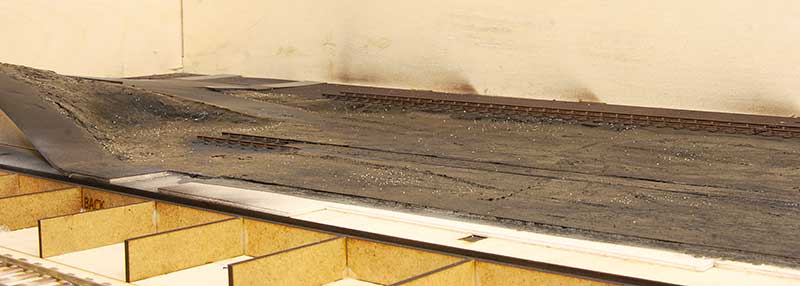
Tracks and tweaks.
Been busy doing the fiddly bits of track for Brettell Road part 2.
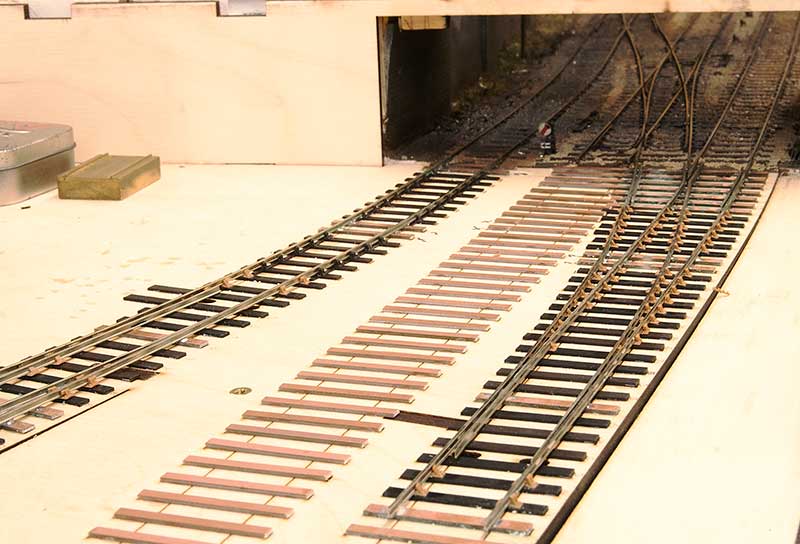 Ok, this is just a B9 on a slight curve, not exactly fiddly.
Ok, this is just a B9 on a slight curve, not exactly fiddly.
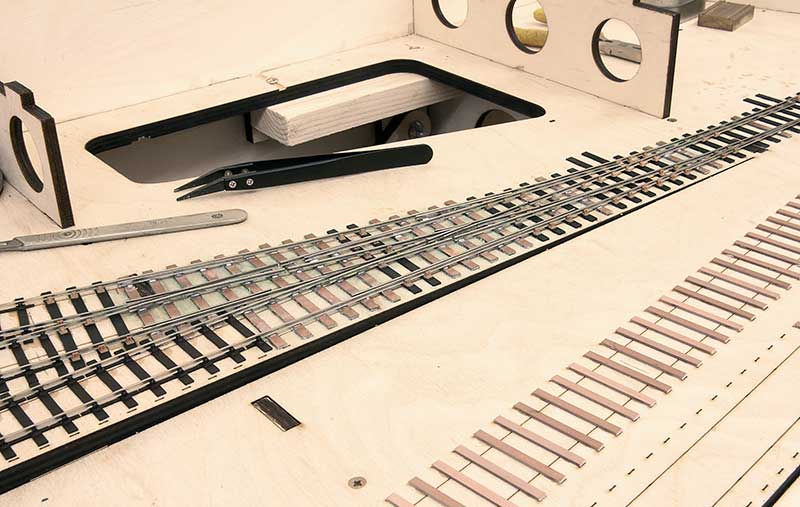 This is a bit more entertaining though. Ive tried a slightly different approach from my usual norm by using more copper clad and building more in situ than I usually do. I normally build the crossing assembly away from the layout but decided this time to only assemble the vees themselves remotely. I think its a bit quicker and allows a little more wiggle room doing it this way.
This is a bit more entertaining though. Ive tried a slightly different approach from my usual norm by using more copper clad and building more in situ than I usually do. I normally build the crossing assembly away from the layout but decided this time to only assemble the vees themselves remotely. I think its a bit quicker and allows a little more wiggle room doing it this way.
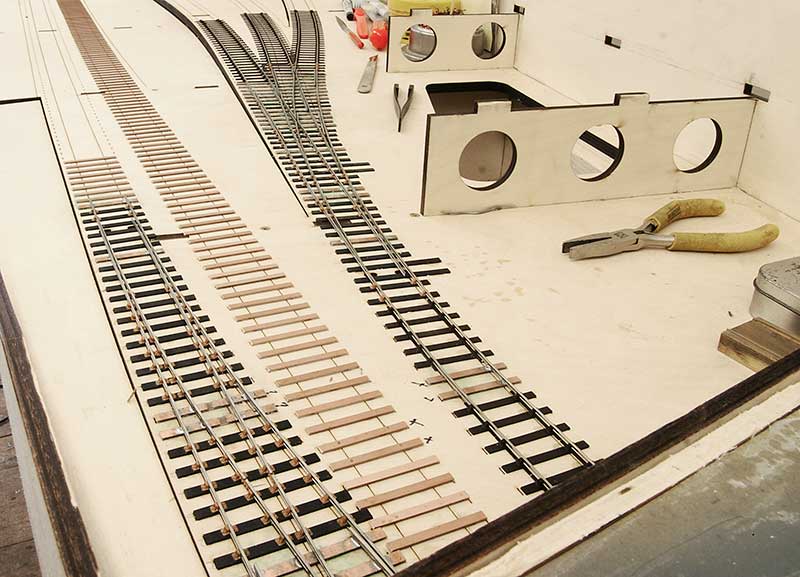 The view from the bridge.
The view from the bridge.
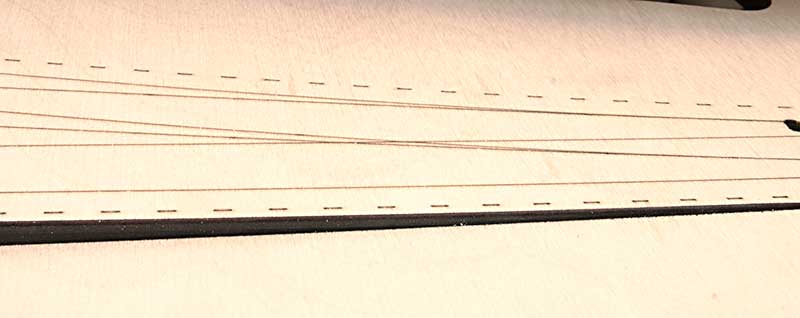 No matter how designed you think something is theres always some tweaks needed when you see the thing in the flesh. I never noticed how the 2 vees had ended up virtually on top of each other.
No matter how designed you think something is theres always some tweaks needed when you see the thing in the flesh. I never noticed how the 2 vees had ended up virtually on top of each other.
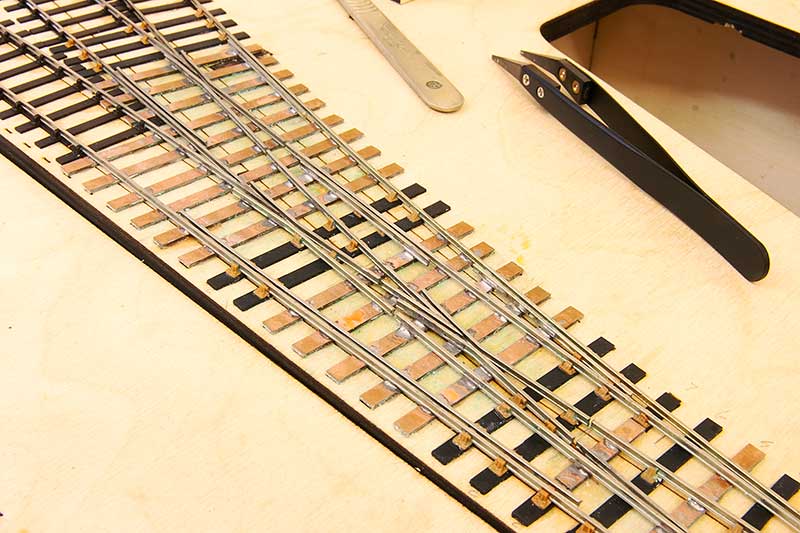 You can see here how the middle road has been realigned. The original alignment showing through under the sleepers.
You can see here how the middle road has been realigned. The original alignment showing through under the sleepers.
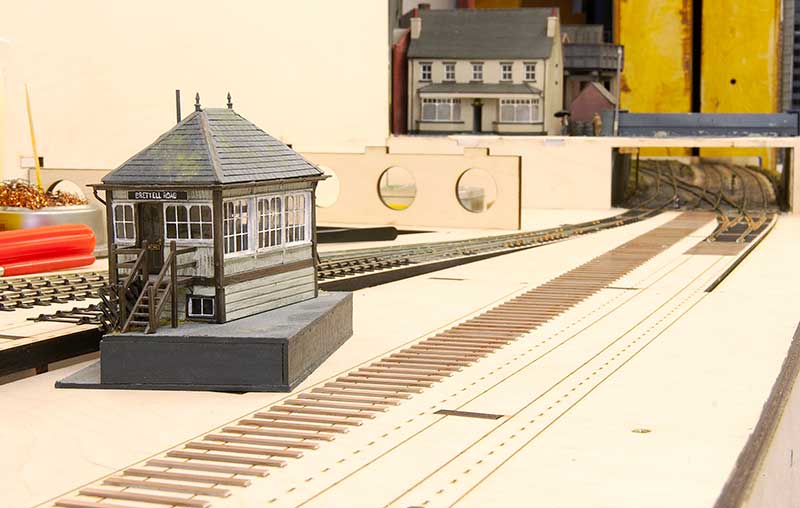 Another tweak is the position of the signal box. I don’t think I fully took into account the curve and the sighting lines are worse than I thought they would be where I put it originally.
Another tweak is the position of the signal box. I don’t think I fully took into account the curve and the sighting lines are worse than I thought they would be where I put it originally.

By moving it to to the other platform and along to the left a bit the sighting lines are much better.

So the signal box will go here instead. I will need to move the steps to the near end and I plan to fit deeper windows so that it more like a type 3 box.

Duchess update June 2021
After a longer gap than would have liked attention had returned to my Duchess build.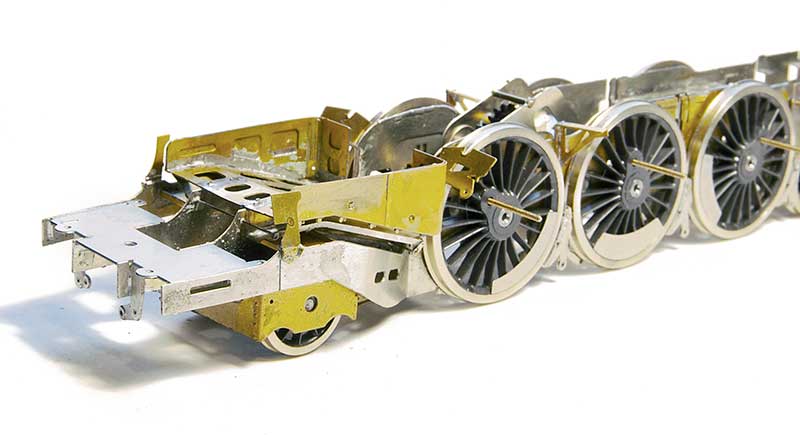 Starting with the lower firebox and damper operating rod.
Starting with the lower firebox and damper operating rod.
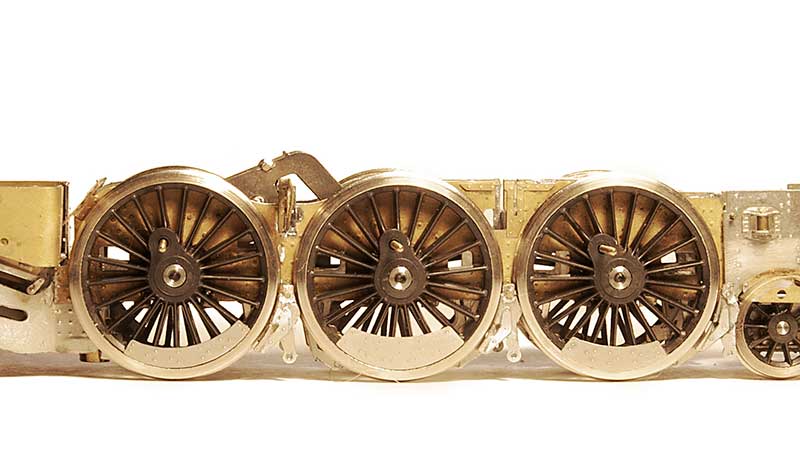 Next up the brakes. As can be seen clearance is kind of on the minimal side. Theres no springs fitted yet either so the chassis will sit a little higher than is seen here.
Next up the brakes. As can be seen clearance is kind of on the minimal side. Theres no springs fitted yet either so the chassis will sit a little higher than is seen here.
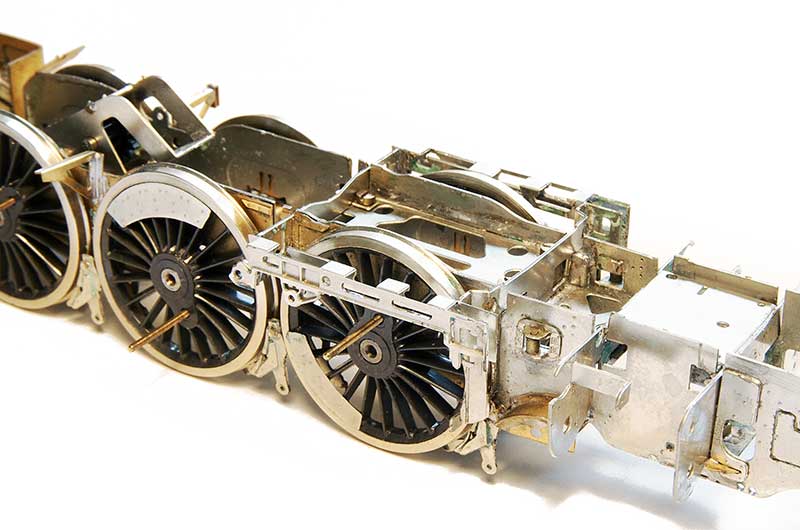 The motion brackets. Again theres not a lot of clearance between the bracket and the leading driving wheel.
The motion brackets. Again theres not a lot of clearance between the bracket and the leading driving wheel.

The chassis so far.
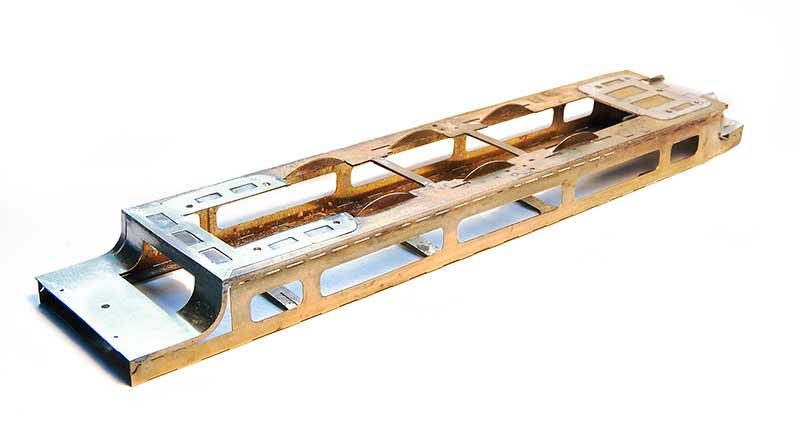 Moving on the next stage is the footplate Seen here in its assembly jig.
Moving on the next stage is the footplate Seen here in its assembly jig.
Brettell Road part 2
I guess I was supposed to be here about a year ago but Covid happened. I actually had a trip over to Tims planned between the first and second lock down but that got delayed to the start of this week. Tim Kindly agreed to me using his laser cutters for 3 days but in the event it only took 2 to do the new boards for Brettell Road. I must say there was only a few of the most minor amendments needed which I was very pleased about and unlike some of our previous efforts next to no scrap bits this time!
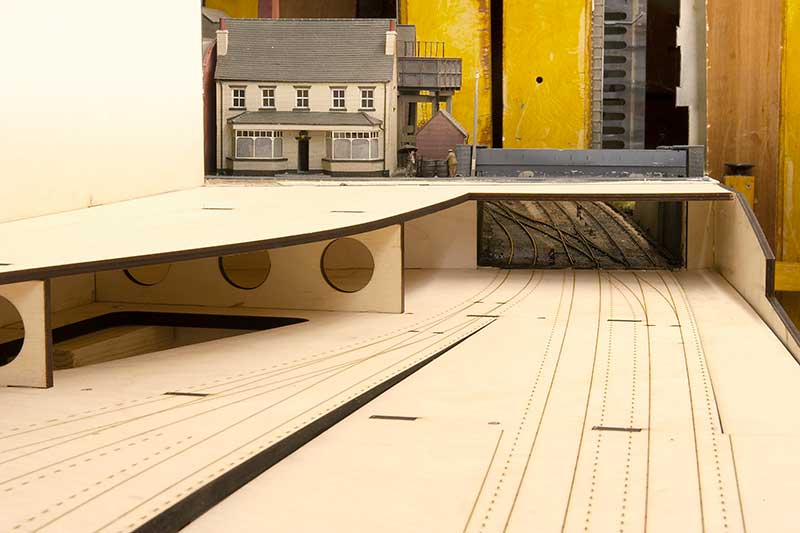 Here we see the new board meeting the old. Perhaps one of the biggest advantages of drawing baseboards up digitally and cutting them on a machine is that everything should be consistent. In the event the track bed was about a mill and half too high which considering I had rebuilt the main lines wasn’t to bad at all. Nothing a few minutes with a saw and a chisel didn’t fix anyway! The end back scene from the original layout has been cut away.
Here we see the new board meeting the old. Perhaps one of the biggest advantages of drawing baseboards up digitally and cutting them on a machine is that everything should be consistent. In the event the track bed was about a mill and half too high which considering I had rebuilt the main lines wasn’t to bad at all. Nothing a few minutes with a saw and a chisel didn’t fix anyway! The end back scene from the original layout has been cut away.
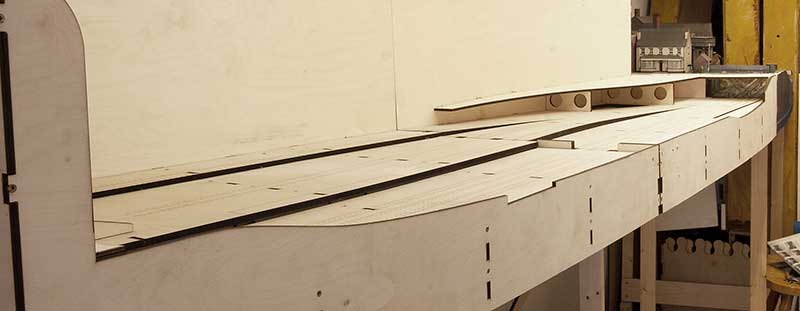 Overview of the 2 new boards. Unlike the previous boards the mainline is flat on these boards with the yard rising behind them. Kings Heath station was the inspiration for this arrangement. Time will tell if I need to get creative about how the wagons in the yard stay put.
Overview of the 2 new boards. Unlike the previous boards the mainline is flat on these boards with the yard rising behind them. Kings Heath station was the inspiration for this arrangement. Time will tell if I need to get creative about how the wagons in the yard stay put.
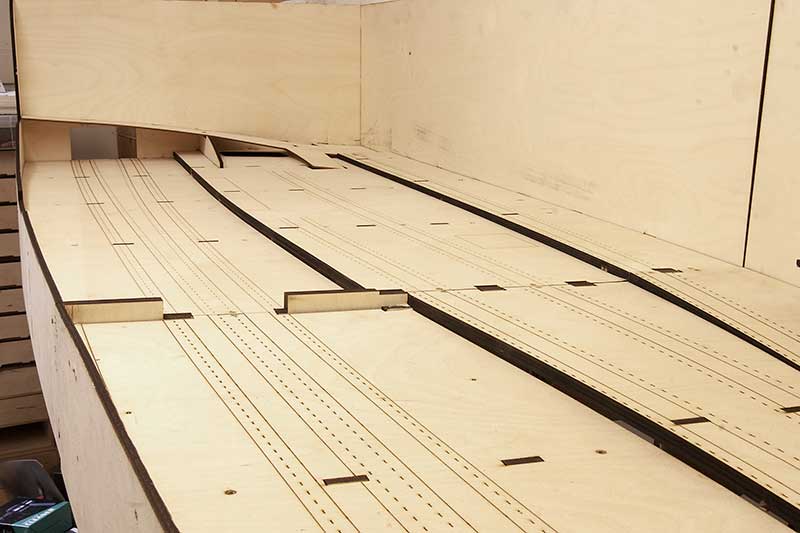 Looking towards Stourbridge. The platforms will fill all of the view here along the mainlines I have a thing for stations with much longer platforms than the trains that serve them. I wonder if its because much of the northern half of the North Warwickshire Line had stations like this (as a kid our garden backed onto it)?
Looking towards Stourbridge. The platforms will fill all of the view here along the mainlines I have a thing for stations with much longer platforms than the trains that serve them. I wonder if its because much of the northern half of the North Warwickshire Line had stations like this (as a kid our garden backed onto it)?
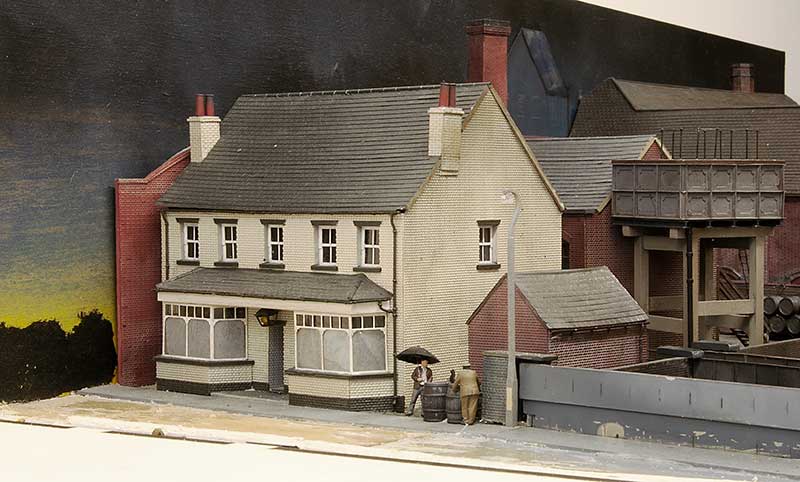 With hindsight it was probably a good thing I was a tad obsessive about the buildings and detailed up the side of the pub that, at the time of building it, I never thought anyone would see!
With hindsight it was probably a good thing I was a tad obsessive about the buildings and detailed up the side of the pub that, at the time of building it, I never thought anyone would see!
Bugs and BTP
A few more vehicles for New Street, starting with…

The VW beetle (this is probably asking for trouble!) Both from Oxford Diecast. On the left I filed off the canvas roof and filled the back window to make an earlier oval window version. This is based on the actual car that a chap I used to work with owned but he did a load of modifications to it not long after he found it in a barn. On the right a ‘cal-look’ version. I ground of the bodyside trim and that on the bonnet off as well as filling in the holes for the bumpers. The front suspension has been lowered and on the back some wheels from a Cararama Porsche.
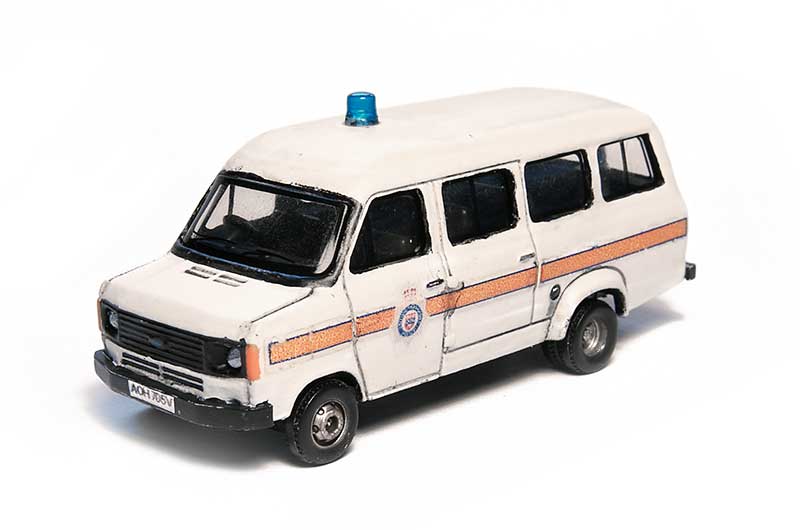 Long time followers might be aware of my liking of the good old Mk2 Transit. My small fleet being a combination of ABS bonnets and Corgi bodies. However now theres Tiny City. A Hong Kong company that does MK2 transits ready to plonk. All of far eastern prototypes and mostly bus type bodies (they do a handy looking ambulance by the way). This one was stripped and re-liveried into British Transport Police livery. My liking of the mundane is pretty well obvious by now however the BTP offices were at New Street station in the 80s and there was always a police vehicle or 2 parked at the station.
Long time followers might be aware of my liking of the good old Mk2 Transit. My small fleet being a combination of ABS bonnets and Corgi bodies. However now theres Tiny City. A Hong Kong company that does MK2 transits ready to plonk. All of far eastern prototypes and mostly bus type bodies (they do a handy looking ambulance by the way). This one was stripped and re-liveried into British Transport Police livery. My liking of the mundane is pretty well obvious by now however the BTP offices were at New Street station in the 80s and there was always a police vehicle or 2 parked at the station.
Nothing new here
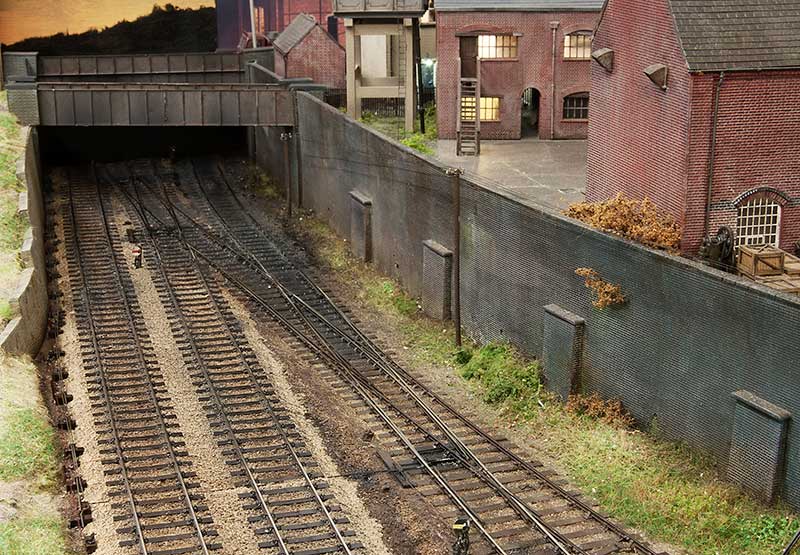 With the point rodding redone and signal wires back in place theres not really anything left to do on Brettell Road part 1. I was hoping to embrace the latest technology with the rodding and decided to go with 3d printed BR stools from Modelu. However those didn’t work out for me at all and proved to be far too fragile. Ive sent them all back and Alan is going to investigate as he believes there was a problem with the resin. I’ll do a follow up post when he comes back with his findings. So as the old adage goes, sometimes its best to stick with what you know I went back to the trusty Brassmasters etched ones instead.
With the point rodding redone and signal wires back in place theres not really anything left to do on Brettell Road part 1. I was hoping to embrace the latest technology with the rodding and decided to go with 3d printed BR stools from Modelu. However those didn’t work out for me at all and proved to be far too fragile. Ive sent them all back and Alan is going to investigate as he believes there was a problem with the resin. I’ll do a follow up post when he comes back with his findings. So as the old adage goes, sometimes its best to stick with what you know I went back to the trusty Brassmasters etched ones instead.
 The cranks are also Brassmasters although I’ve used the MSE bases as I thought they were better. The rodding itself and signal posts are also from MSE with the signal wires from ezline. Unlike the previous version where I made some of the point rodding work, just to see if i could, I didn’t feel any need to to it again.
The cranks are also Brassmasters although I’ve used the MSE bases as I thought they were better. The rodding itself and signal posts are also from MSE with the signal wires from ezline. Unlike the previous version where I made some of the point rodding work, just to see if i could, I didn’t feel any need to to it again.
 A few more detectors for the ground signals were knocked up from bits of brass and my rain technique of coats of Tamiya smoke and AK wet effects fluid reapplied. I guess you could say I’m back to where I was a few months ago!
A few more detectors for the ground signals were knocked up from bits of brass and my rain technique of coats of Tamiya smoke and AK wet effects fluid reapplied. I guess you could say I’m back to where I was a few months ago!
 Theres something oh so familiar about glimpses of grubby track between bridges and retaining walls.
Theres something oh so familiar about glimpses of grubby track between bridges and retaining walls.
 At the other end of the layout the extra bits of the bridges have been added.
At the other end of the layout the extra bits of the bridges have been added.
 One thing I forgot to mention before is this stuff. Its great for fixing ballast and while its no where near as cheap as the traditional PVA/ water/ washing up liquid concoction it can be used straight from the bottle with no messing around wetting everything first.
One thing I forgot to mention before is this stuff. Its great for fixing ballast and while its no where near as cheap as the traditional PVA/ water/ washing up liquid concoction it can be used straight from the bottle with no messing around wetting everything first.
9th May 2021

Behind the scenes I have migrated the site to a new hosting company. All has gone pretty well but there was an oops! I did lose was the subscribers list, unfortunately. So with apologies can I ask all those who wish to still receive updates re-subscribe to the site? Its dead simple. Click on any of the workbenches and on the right where it says follow you can pop in your email. Remember to click the confirmation link in the email you are sent and thats it. Again apologies for the inconvenience and if you spot anything else thats broken feel free to drop me an email.
Wires and signals
Part of the process in upgrading Brettell Road and preparing it for part 2 was to redo the wiring. Those that have been following from the start will recall that it was initially only a plaything and not an exhibition layout and the wiring reflected that being just 4 wired between boards. 2 for the DCC and 2 for the AC supply. A concession was made after the first show to provide short protection for each board but its not really how things should be done so its been mostly stripped out and done again.
So now the DCC is split into 3 sections. One for the yard, one for the mainlines and one for the accessories. Theres little point having short protection if said short cuts off the ability to throw the points and resolve it. The AC is also split into 2 sections as well, the second being a DC supply for LEDs. You can use AC for LEDs anyway but the flicker can be noticeable sometimes. So now theres 10 wires between boards instead.
Signals
The new arrangement for entering the yard has required a few new signals as well.  Mainly a couple of ground signals from the MSE kits. I need a couple more for part 2 (one of which is a double) so I built them all together. these are powered by servos controlled by a Tam Valley control board.
Mainly a couple of ground signals from the MSE kits. I need a couple more for part 2 (one of which is a double) so I built them all together. these are powered by servos controlled by a Tam Valley control board.  I guess this also comes under signals? A simple limit of shunt sign from a MSE lamp a bit of brass tube and some microstrip.
I guess this also comes under signals? A simple limit of shunt sign from a MSE lamp a bit of brass tube and some microstrip.
Below a couple of mood shots .


No going back now! part 2
Well the engineering works, true to form, over ran and took a bit longer than I expected. However the mini people of Brierley Hill will be pleased to hear that services can resume. I used to be a fan of the JLTRT track colour spray paint but as that range is long gone now and my last can was pretty much done for an alternative was required. Halfords do a ‘camouflage’ range of very matt colours in their rattle cans and the brown is ideal as a basic track colour.
I used to be a fan of the JLTRT track colour spray paint but as that range is long gone now and my last can was pretty much done for an alternative was required. Halfords do a ‘camouflage’ range of very matt colours in their rattle cans and the brown is ideal as a basic track colour.  The completed track ballasted and weathered from under the bridge. The blocks on the right are for the point rodding and I haven’t fitted the point motors yet.
The completed track ballasted and weathered from under the bridge. The blocks on the right are for the point rodding and I haven’t fitted the point motors yet. 
 The left hand end from the other side of the bridge. I have a couple of ground signals to add yet.
The left hand end from the other side of the bridge. I have a couple of ground signals to add yet. 
 And the right hand end. This is the end that required the most adjustment of whats already there.
And the right hand end. This is the end that required the most adjustment of whats already there.  The bridges over the canal have been adapted to fit in their new locations. I still have a bit of work to bed them in properly and I intend to fit a couple of central girders between the tracks on both levels.
The bridges over the canal have been adapted to fit in their new locations. I still have a bit of work to bed them in properly and I intend to fit a couple of central girders between the tracks on both levels.  The nearer buffer stop has been repositioned slightly and a new bridge built. I decided to angle it a little and do a bit of scruffy road to go behind it.
The nearer buffer stop has been repositioned slightly and a new bridge built. I decided to angle it a little and do a bit of scruffy road to go behind it.  Old meets new!
Old meets new!
No going back now! Part 1
It seems that the good folk of Brierley Hill need to rely on buses for a while… …Brettell Road is currently somewhat disrupted! Work progressing on the plan to double track the layout. One of the advantages of designing a layout on a computer and having a friendly laser cutting chap is you can design bits to replace things you really should have thought more about the first time!
…Brettell Road is currently somewhat disrupted! Work progressing on the plan to double track the layout. One of the advantages of designing a layout on a computer and having a friendly laser cutting chap is you can design bits to replace things you really should have thought more about the first time!
Ive talked before about the regret at not making the layout a double track and I’ve also touched on using MDF as a trackbed which turned out to be a tad too unstable. The main lines have been replaced with 6mm ply and a hole cut for it to sit in. Pictures of Brettell Lane in the period show some encroachment of flat bottom trackwork but in the form of pointwork. Further down the line, north of Dudley the Midland lines were also flat bottom in the period I am modelling and since Brettell road has always been more Midland anyway I decided to go with flat bottom trackwork for the plain lines. Specifically mills clips courtesy of Colin Craig. (the actual clips will be added after testing.

Chains of slips under bridges all seem oddly familiar for some reason! Like my other model nothing in this one is straight either!
Thanks to Colin and Tim for their assistance in supplying bits.
Bogie Ballast hoppers
The plan for New Street has always been to feature a selection of engineers trains. The ones I have had in mind are a rake of loaded mainly 4 wheeled hoppers, a rake of loaded bogie hoppers, a rake of loaded grampus style wagons (partially fitted), a rake of empty salmons and a mixed rake of unfitted oddities(also empty). All of these trains have been started to a degree and most of them many years ago. However I had an urge to get at lease one of these trains finished off and it was the bogie ballast hoppers that appealed the most.
These have been pretty much done for years with most just needing the hand wheels and safety screens finishing off.
 The oldest model is an old Cambrian kit for a Sealion. Because this model does look a little different to all the others it will actually form part of the 4 wheel rake so that it doesn’t stand out.
The oldest model is an old Cambrian kit for a Sealion. Because this model does look a little different to all the others it will actually form part of the 4 wheel rake so that it doesn’t stand out.
 Next up a couple of Lima Sealions. An excellent model for its time let down only by the odd bogies. Ive replaced them with Cambrian ones.
Next up a couple of Lima Sealions. An excellent model for its time let down only by the odd bogies. Ive replaced them with Cambrian ones.
 The Lima tooling went to Hornby and rather than just stick it in a ‘railroad’ range box they did actually do some decent upgrades to this model. Mainly the bogies but also adding the safety screens. The rest is as Lima designed it with the exception of Hornby moved the end handrails from the top of the platforms to the buffer beams and replaced the inner original handrails (which were plastic) with better wire ones.
The Lima tooling went to Hornby and rather than just stick it in a ‘railroad’ range box they did actually do some decent upgrades to this model. Mainly the bogies but also adding the safety screens. The rest is as Lima designed it with the exception of Hornby moved the end handrails from the top of the platforms to the buffer beams and replaced the inner original handrails (which were plastic) with better wire ones.
 The above image serves to show the changes made. The hand wheels have been replaced with Stenson Models etched ones and the safety screen, while a commendable effort, wasn’t fine enough in my eyes. I’ve used cut down etches from Extreme etches intended for the class 56 bodyside grills. I also replaced the buffer heads with some from MJT. The livery Hornby applied to these seem to be a hybrid of the earlier light grey version applied in the later dark grey style. I couldn’t find any like this so the lower black band was added.
The above image serves to show the changes made. The hand wheels have been replaced with Stenson Models etched ones and the safety screen, while a commendable effort, wasn’t fine enough in my eyes. I’ve used cut down etches from Extreme etches intended for the class 56 bodyside grills. I also replaced the buffer heads with some from MJT. The livery Hornby applied to these seem to be a hybrid of the earlier light grey version applied in the later dark grey style. I couldn’t find any like this so the lower black band was added.

 Also from Hornby the later welded Seacow. Again the screens were replaced. These too had the lighter grey livery so they were resprayed into the darker grey.
Also from Hornby the later welded Seacow. Again the screens were replaced. These too had the lighter grey livery so they were resprayed into the darker grey.
 Bachmann have also done a Sealion and theres not a lot wrong with it as it comes. I still changes the screens and hand wheels for consistency throughout the rake.
Bachmann have also done a Sealion and theres not a lot wrong with it as it comes. I still changes the screens and hand wheels for consistency throughout the rake.
 The super easy conversion to a lima Sealion is to remove the vacuum cylinders to turn it into a Seacow. Lima did brand some of their RTR models Seacow but they retained the vacuum gear.
The super easy conversion to a lima Sealion is to remove the vacuum cylinders to turn it into a Seacow. Lima did brand some of their RTR models Seacow but they retained the vacuum gear.
 A more involved conversion is to stretch the lima model to produce the larger 50ton Whale. These were started way before the Cambrian Kit appeared although they do now ride on their bogies. Hand wheels are again from Stenson models.
A more involved conversion is to stretch the lima model to produce the larger 50ton Whale. These were started way before the Cambrian Kit appeared although they do now ride on their bogies. Hand wheels are again from Stenson models.

Although a modest train for New Street its still virtually as long as Brettell Road!
Bit of a mixed bag
Bit of a mixed bag this post, starting with;
A kind gift.
My friend Tom contacted me to say he had an old Millholme models kit for an LMS 30t bogie bolster and did I want it? Of course it would be rude not too!
The kit represents, as best as I can tell, a diagram 1682 45 ft bogie bolster. These were a continuation of a Midland design with the only obvious difference being that the earlier ones had handbrake wheels rather than compound levers. The sides and solebars were, nicely, cast in one piece and being as old kit the bufferbeam and ends where missing. The trussing was also cast in whitemetal and was somewhat optimistic as its a long piece in a not very strong and somewhat bendy material.
 So to work I replaced all the trussing with 1mm L section brass from Eileens. The brake lever castings were OK and they are both mounted at one end. It appears that only the bogie at this end is braked at all.
So to work I replaced all the trussing with 1mm L section brass from Eileens. The brake lever castings were OK and they are both mounted at one end. It appears that only the bogie at this end is braked at all.
 The bogies are ratio ones and I ditched the swivelling plate idea as supplied preferring to pack them out and mount them with a screw. The bufferbeams were from my scrap kit parts box and the extra rivet detail from Archers transfers. The buffers were the ones supplied in the kit.
The bogies are ratio ones and I ditched the swivelling plate idea as supplied preferring to pack them out and mount them with a screw. The bufferbeams were from my scrap kit parts box and the extra rivet detail from Archers transfers. The buffers were the ones supplied in the kit. 
Lampost conundrum
My plan to extend Brettell Road includes completing the road currently on the left of the layout as well as adding a new road. Digging around looking at local pictures in the late 50s the lamposts seem to be mostly the concrete cast type. Theres a couple of options for these. Hornby Scaledale none working ones and woodland scenics working type. I immediately discounted the latter as they are far too chunky and just look awful.
 Not that the Hornby ones look any better. Im not sure why they bothered to produce these as they are basically crude lumps of resin and they don’t even provide a foot for modellers to mount them. The idea of fitting a surface mount LED and hiding the wires on the none viewing side went out of the window! I must be able to do something better than this surely? Especially as, at most I will only need 5 of them.
Not that the Hornby ones look any better. Im not sure why they bothered to produce these as they are basically crude lumps of resin and they don’t even provide a foot for modellers to mount them. The idea of fitting a surface mount LED and hiding the wires on the none viewing side went out of the window! I must be able to do something better than this surely? Especially as, at most I will only need 5 of them. So with some K&S metal section (1.5mm square for the top and 2.4mm Hex for the main trunk I made this.
So with some K&S metal section (1.5mm square for the top and 2.4mm Hex for the main trunk I made this.  The base was blended into the main columns and sprayed with Plasticote suede. I also very lighty dusted some grey primer and blank over it to give a more concretey colouring. Below is how it looks in position.
The base was blended into the main columns and sprayed with Plasticote suede. I also very lighty dusted some grey primer and blank over it to give a more concretey colouring. Below is how it looks in position. 
Baby Grampus
Flicking through Simon Bendall’s bookazine ‘Modelling British Railways – Engineers wagons’ I was taken by a wagon I’d not come across before. The GWR designed ling. A 14 ton open wagon that looks like a baby grampus. In the bookazine, Hywel Thomas built one by cutting down a Chivers Tunney but I decided another route would be to stretch a Cambrian starfish instead.  So 2 starfish kits were found and a lot of cutting ensued. The doors on a Ling are shorter than a Starfish so each door had a section cut from the middle with new strapping from microstrip. Buffers are from Lanarkshire models, W irons from Bill Bedford, door bangers and steps from Rumney Models and the test of the underframe from plastic section and the spares box.
So 2 starfish kits were found and a lot of cutting ensued. The doors on a Ling are shorter than a Starfish so each door had a section cut from the middle with new strapping from microstrip. Buffers are from Lanarkshire models, W irons from Bill Bedford, door bangers and steps from Rumney Models and the test of the underframe from plastic section and the spares box.
 Above is the reason i referred to this wagon as a baby grampus. Along side one it’s considerably smaller. Comparisons between the shortened doors and the starfish originals can also be seen.
Above is the reason i referred to this wagon as a baby grampus. Along side one it’s considerably smaller. Comparisons between the shortened doors and the starfish originals can also be seen.
18th February 2021
Goodies
As I developed parts for my models, some may have been of interest to others. I was not a trader as such and I did not hold stocks of all of these items all of the time. I also do not do commissions. As time went on I found, working full time shift work I couldn’t devote the time I needed to do this properly and so I regret that I will no longer be able to offer any of the parts I developed to others going forward.
Should this at some point in the future change I will re-add my goodies to the goodies page but only if they are in stock and available.
Midland brake van evolution – a visual guide.
One thing the Midland did well was use standardised bits and adapted them as they went along. This is quite noticeable in their signal boxes but also in their brake vans and, visually at least, the evolution is pretty obvious and logical. So from left to right…
 So starting with the early midland 10 ton van. This was very much of its time and featured 3ft 6in wheels with a veranda at one end only. The open platform thats so familiar to the idea of a brake van wasn’t something that the Midland really went with and only one lot (D2096) of 4 vehicles would feature this in the future. The rest of standard Midland brake vans would all feature a full length roof.
So starting with the early midland 10 ton van. This was very much of its time and featured 3ft 6in wheels with a veranda at one end only. The open platform thats so familiar to the idea of a brake van wasn’t something that the Midland really went with and only one lot (D2096) of 4 vehicles would feature this in the future. The rest of standard Midland brake vans would all feature a full length roof.
The later 20 ton van was built to diagram 1659 between 1924 and 1927 and featured a longer 12 ft wheelbase with 3ft wheels and a cabin that was 13ft 4in inside. This would become the standard size cabin for the rest of the midland vans that followed The similarities between the 2 type shown are pretty obvious with vertical planking and basically the same end panels.

Next came diagram 1657 (the diagram numbers don’t seem to follow in a chronological order) built between 1927 and 1931. The obvious change was the duckets on the side. The outer ends also evolved to feature a smaller opening and flush planking but still with the same offset central vertical spar.
 From diagram 1657 to diagram 1940 built in 1933/34. Virtually identical except for an increase in wheelbase of 14ft which resulted in a visually less nicely proportioned vehicle. It’s suggested that the increase was an attempt to improve stability at higher speeds.
From diagram 1657 to diagram 1940 built in 1933/34. Virtually identical except for an increase in wheelbase of 14ft which resulted in a visually less nicely proportioned vehicle. It’s suggested that the increase was an attempt to improve stability at higher speeds.
 On to diagram 1890 also built in 1933/34. Still 20 tons but with another wheelbase increase to 16ft and an increase on overall length from 20ft to 24ft. The cabin size remained the same but there was a change from vertical to horizontal planking. Note the end central spar now really is central!
On to diagram 1890 also built in 1933/34. Still 20 tons but with another wheelbase increase to 16ft and an increase on overall length from 20ft to 24ft. The cabin size remained the same but there was a change from vertical to horizontal planking. Note the end central spar now really is central!
 Finally diagram 2036. Basically the same as before but with the door opening moved to the far end. The planking on the ends is now gone as is the central spar as well as the upper part of the opening following the roof line. There were a few slightly different variants of this design such as diagram 2068 (the last being built in 1950) which featured a deeper ballast box between the wheels. Some of this last batch were also fitted although many of the other types were through piped at times in their lives.
Finally diagram 2036. Basically the same as before but with the door opening moved to the far end. The planking on the ends is now gone as is the central spar as well as the upper part of the opening following the roof line. There were a few slightly different variants of this design such as diagram 2068 (the last being built in 1950) which featured a deeper ballast box between the wheels. Some of this last batch were also fitted although many of the other types were through piped at times in their lives.
